Modern Catamaran Trends: Gimmicks or Valid Design Ideas?
The celebrity of the catamaran is not only swelling in racing, but also for cruising catamarans. At their conception, the atypical design enabled cats to sail faster and in shallower waters with less wind and crew than other sailing vessels. But for years the unorthodox design met with skepticism, leaving the catamaran with little commercial success. Additional challenges to adoption of early versions of cruising cats were the small, very cramped interiors by modern day standards, was heavy and lumbering handling abilities. Many sailors used to say they “were built like tanks and sailed like bricks”.
However, sailors soon realized that nothing could beat the comfort, speed, and safety of a well-designed modern catamaran as a cruising yacht. These vessels can achieve the highest speed for the smoothest ride and boast the most interior space and greatest safety of most ocean-going vessels. Sailors of all types are quickly overcoming earlier prejudices against the multihull design as contemporary design trends continue to produce catamarans that are faster, more exciting, more visually interesting, and safer than ever before.

The New Trends
Fun and interesting new trends in catamarans make sailing even more exciting than ever before. However, innovations are only useful if they contribute to good design, construction, and safety principles and it should fit your sailing purposes. Let’s take a look at some trends in modern cats:
1. Larger Catamarans for Fewer Crew
The new generation of catamaran, using modern composite construction and engineering can be built lighter, larger, and more spacious with very good power-to-weight characteristics. Currently, the trend leans increasingly towards larger catamarans. The average catamaran for a cruising couple now tends to be more in the 45ft to 50ft range. With composite engineering and installation of technologically advanced equipment, e.g., electric winches, furling systems, and reliable auto pilot, it is now possible for shorthanded crews to confidently sail larger boats with larger rigs. Technology has enabled modern catamarans’ bigger volume with more stiff and torsion resistant construction, without compromising stability and safety.
2. Inside Out: Convertible Main Living Areas
The design improvements of convertible living areas not only increases usable space and opens up the living areas, but also reduces interior maintenance and cleaning issues of traditional varnished wood surfaces. An open and convertible main living area with simple, hard-wearing composite materials reduces costs and time required to clean and maintain the boat. Big windows and opening vents allow light in and increase visibility. Gone are the submarine-like claustrophobic cabins typical of most traditional yachts. Owners’ cabins are luxurious, airy, and spacious serving as a very comfortable living space, rather than just a place to sleep.
3. Wave-Piercing or Reverse Bows
4. bulkhead helm stations or twin stern steering.
However, Gunboat moved the cockpit back under cover in its latest designs, just as Leopard introduced a forward cockpit with opening doors into the leisure-focused salon in their Leopard 44 and 48 models. The team at Catamaran Guru questions the suitability of this design feature for blue water catamarans that will encounter large seas, but nonetheless, it is a popular trend especially for the yacht charter market.
Ultimately for a cruising catamaran, our preference is a safe, protected helm station with good visibility and all the control lines leading back to the helm to create a static control station. Push-button controlled winches and windlass as well as the instruments and autopilot should be prominently located and protected within the cockpit.
5. The Flybridge Trend
Getting from the cockpit up to the flybridge and back down in bad weather can prove unsafe. To accommodate the flybridge, the goose neck and boom must be very high making stowing the main problematic. The higher gooseneck position also means that the center of effort is higher which impacts the vessel’s righting moment and is not as good as catamaran with a lower boom position and bulkhead steering. Just where the flybridge design will go is anybody’s guess but right now it has huge appeal for a lot of people.
6. Hydrofoils and Daggerboards
Because of design innovations like curved daggerboards and the hydrofoils, performance on cruising catamarans has improved tremendously but catamaran speed is relative. The most important benefit of speed of a multihull is the ability to outrun bad weather. Being able to average 2-3 knots faster on a catamaran than on a monohull, can help avoid bad weather. Many cruisers often tell us at Catamaran Guru, “I don’t care about performance,” but its not long before they understand that the heavy cruising cat is not quite as comfortable at sea – AND very slow. It makes no sense to buy a catamaran that will not sail at least 200nm per day when making passage.
7. Galley Up or Down
In modern catamarans, the most popular trend currently is galley up, making it a focal point of the main living and entertainment areas. When at sea, every meal comes from the galley, so live-aboards spend a lot of time in the galley and many cruising couples and families find that the separation of galley down in a hull is not ideal. When at sea, hauling hot food up and down the stairs is a safety hazard. Having the galley on the same level as the serving area and cockpit is less tiring and safer. Also, ventilation is better on the bridgedeck than down in the hulls, which makes cooking more comfortable, especially if you are prone to seasickness. The disadvantage of the galley up design is less privacy for the cook’s messes and it can significantly impact the size of the saloon seating area, especially on smaller cats.
Some manufacturers like the St Francis 50 and Antares 44 still trust in the galley down design. Galley down is often preferred for charter boats because it provides a private, self-contained cooking area with dedicated prep areas and utilizes space in the hull that might otherwise be less efficiently used. However, the most popular trend is galley up and it makes sense to most sailors, especially cruising couples and families.
More on our take for galleys up or down .
Is Speed and Interior Comfort Trumping Good Design?
- Catamaran stability is a function of beam and buoyancy, so light-weight strong construction, which translates into buoyancy, is a good thing. Typically cruising catamarans have a beam-to-length ratio of roughly 50%, meaning a 45′ long cat will be about 22′ wide. This will not only result in great interior space but also in a very stiff and efficient boat.
- The boat needs to have a robust COG (center of gravity) through good buoyancy fore and aft or waterline length to avoid “hobby horsing”, making for a smoother ride and better performance. Performance is a safety issue; it is always better to have the pace to get out of the way of bad weather. So some speed in reserve is great.
- Good bridgedeck clearance is important for seaworthiness and crew comfort at sea, by reducing slamming and better performance in rough conditions. However, a very high bridge deck clearance, together with, say 6.5ft of headroom in the saloon, the boat will be very high with a lot of windage. So there has to be a balance struck between bridge deck clearance and the height in the salon. A good rule of thumb for bridge deck clearance is to have good clearance is about 5% of overall length of the hull but 6% is excellent. A clearance of 4% is acceptable but on the low side.
Even in the age of computer modeling, yacht design remains a series of compromises and the use of a boat will dictate its visual design and performance characteristics to a large degree. A well-designed catamaran is ergonomic and pleasing to the eye. It should be sensible and safe, with performance that can get to a safe harbor when necessary. It all comes down to safety and comfort, especially in rough conditions.
Looking to buy a yacht? Contact us if you have any questions regarding catamarans for sale , Fractional Yacht Ownership or our Charter Management Programs .
Estelle Cockcroft
Join our community.
Get the latest on catamaran news, sailing events, buying and selling tips, community happenings, webinars & seminars, and much more!
2 thoughts on “Modern Catamaran Trends: Gimmicks or Valid Design Ideas?”
Good reading, informative and to the point. There is no reference to building standards and codes of practice. The Catamaran industry needs to “mature “ as more models and brands enter the market with the consumer paying for the downward spiral. Look forward to your next article.
Hi Gregor, you are right. There is no one uniform set of standards. Most countries have published guidelines, codes or laws that a boatbuilder must follow in order to sell a boat in that country. Some of the better known ones are USCG, ABYC, CE, AS/NZS and ABS. There is a lot of similarity between the different international regulatory bodies but just as many differences. Enforcement of these standards are sketchy. Labels are applied to boats i.e. “in compliance,” “certified” or “classified.” and it all means little if not enforced. In the US, it’s mostly up to the builder to voluntarily comply with the published guidance ( the all do since it’s in their interest). In the European Union, by law a boat has to be inspected, documented and certified. Australia and New Zealand publish their own set of rules. So it’s a miss mash of laws and rules and it’s hard for the consumer to pin down!
Leave a Comment Cancel Reply
Your email address will not be published. Required fields are marked *
Save my name, email, and website in this browser for the next time I comment.
Recent Posts
Bali catamarans unveils the new bali 5.8 flagship.
CATANA GROUP launches its 14th BALI CATAMARAN model, the BALI 5.8, for the brand’s
Love Stories At Sea…because it’s valentine’s day
Because it’s Valentine’s day, we wanted to celebrate all the couples that we helped
Your Go-To Resource for all your Catamaran Needs!
Check out our brochure to learn about all we have to offer and why
Yacht Manufacturers Bankruptcies: How to protect yourself
Silent Yachts, a company specializing in the production of solar electric catamarans, has recently
For more than 30 years, we have been a part of the catamaran community and created Catamaran Guru™ to encourage and educate all the aspiring sailing out there. We understand the dream of traveling the world by catamaran and created a one-stop-shop to make that dream a reality for you.
- Stephen & Estelle
- Testimonials
Get Started
- Yacht Sales
- Used Yachts
- Charter Management
- Boat as Business Programs
- Seminars & Events

The global authority in superyachting
- NEWSLETTERS
- Yachts Home
- The Superyacht Directory
- Yacht Reports
- Brokerage News
- The largest yachts in the world
- The Register
- Yacht Advice
- Yacht Design
- 12m to 24m yachts
- Monaco Yacht Show
- Builder Directory
- Designer Directory
- Interior Design Directory
- Naval Architect Directory
- Yachts for sale home
- Motor yachts
- Sailing yachts
- Explorer yachts
- Classic yachts
- Sale Broker Directory
- Charter Home
- Yachts for Charter
- Charter Destinations
- Charter Broker Directory
- Destinations Home
- Mediterranean
- South Pacific
- Rest of the World
- Boat Life Home
- Owners' Experiences
- Interiors Suppliers
- Owners' Club
- Captains' Club
- BOAT Showcase
- Boat Presents
- Events Home
- World Superyacht Awards
- Superyacht Design Festival
- Design and Innovation Awards
- Young Designer of the Year Award
- Artistry and Craft Awards
- Explorer Yachts Summit
- Ocean Talks
- The Ocean Awards
- BOAT Connect
- Between the bays
- Golf Invitational
- Boat Pro Home
- Pricing Plan
- Superyacht Insight
- Product Features
- Premium Content
- Testimonials
- Global Order Book
- Tenders & Equipment

The coolest new catamaran models and concepts
Sam Fortescue reveals the latest multihulls to make a splash and takes a look at what’s on the designers’ drawing boards
Sunreef 43m Eco
LOA 42.7m Beam 15.4m Power 2 x 200kW Passengers 12 guests, 7 crew
Polish catamaran builder Sunreef has just sold another 43M Eco – the second largest sailing cat in the world. This is hull No 2, and will feature the same innovative 60kW solar array as the first example. Solar cells are integrated into every surface of the hull, superstructure and rig to give it impressive range under electric propulsion and almost limitless power for domestic comfort. The boat has an invisible drop-down aft garage for toys, fold-down wings on the quarter and a vast beach club, which combine to form what Sunreef has dubbed the Ocean Lounge. A gym with a view is built into the starboard quarter, and there’s a huge flybridge and room for 12 guests below.
BlackCat 36m
LOA 36m Beam 13.7m Draught 1.60-4.90m Passengers 8 guests, 4 crew
Designer Malcolm McKeon and BlackCat founder Mitch Booth have been busy creating a super-sleek new 36-metre catamaran concept for a specific owner, and are now offering it alongside its other models in the 30- to 50-metre range. There’s barely a straight line on board; everything is curved and ergonomic – what Italian design is to furniture, so BlackCat is to catamarans. Compared to other BlackCats, there is perhaps a little extra height in the superstructure, plus solar panels and drop-down bulwarks aft. Naturally, it is a full-carbon build with performance to match – this one is predicted to sail at up to 30 knots, setting 650 square metres of carbon sails on its 45-metre rotating mast. Retractable rudders and daggerboards promise tight wind angles and upwind speed as well as access to shallow waters. Electric propulsion and up to 50kW regeneration capacity will minimise fuel burn. There are four double cabins for eight guests. The boat would be built at Baltic Yachts with BlackCat consulting.
Echo Yachts 56m
LOA 56m Beam 15.5m Passengers 16 guests, 14 crew
Echo Yachts has come up with a beast of a catamaran design that blurs the line between support mothership and boat. This 56-metre is designed around helicopter operations, with two landing spots and room for two aircraft in the hangar. That gives it the capacity to carry three helicopters, as well as a range of large tenders up to around 11 metres and numerous other toys. Not that guest-level comfort has been neglected: there’s a spa pool on the foredeck, a private aft deck lounge and a huge beach club based around the drop-down platform. The interior is 100 per cent customisable, and can be skewed towards crew accommodation or even scientific, humanitarian or special interest facilities.
Alva Yachts Ocean Eco 90 H2
LOA 27.5m Beam 13.98m Draught 1.2m Power 2 x 250kW
Alva Yachts is building the world’s first 27.5-metre fossil-fuel-free catamaran. The Ocean Eco 90 H2 will run off two electric motors connected to a 500kWh-plus battery pack, powered by the sun via 200 square metres of solar panelling. It will also be fitted with Ayro’s Oceanwings with sensors on the wingsails. Wind data will be analysed by a computer that will adjust the wingsails’ angle of attack and camber. “This project would not be possible without our classification partner DNV, which has established new ground rules because this has never been done before,” says Holger Henn, CEO of the German builder.
McConaghy MC115
LOA 35m Beam 12.5m Draught 1.8m (centreboards up)
Composite wizard McConaghy has given us an exclusive preview of a new 35-metre catamaran that is still at the design stage. Intended to bridge the gap between production and superyacht sectors, it is even more customisable than the yard’s smaller models. It features wide side decks and an open flybridge with an enclosed helm station forward, at the mast foot.
With sail controls concentrated above, the main deck is devoted to socialising, with a huge hydraulic bathing platform aft. The master suite is positioned forward on the main deck, giving it access to a foredeck lounge with a spa pool – a departure for this performance-focused brand. Accommodation is for 12 guests in six cabins, supported by a crew of four. But the precise configuration is infinitely adaptable. This should be a rapid boat, courtesy of slick naval architecture by Ker and a high-tech composite build. “The MC115 is a wind-speed yacht, and with true wind speed of 20 knots and the boat at 100 degrees, she will comfortably achieve 21 knots,” says managing director Mark Evans.
LOA 36.75m Beam 13.85m Draught 2m Power 2 x 340hp e-motors
Flagships on this scale don’t come quickly, and especially not when they keep growing. What began as a 30-metre now surpasses 36 metres, with its electric drives and helicopter landing pad covered with retractable solar panels. To keep us hooked as the 2024 launch date draws closer, Silent Yachts has released details of a specially adapted submersible and quadcopter designed to match the yacht. U-Boat Worx is behind the two-person Nemo sub, which can dive to 100 metres. And the aircraft is an adaptation of VRCO’s XP4, due for regulatory approval in 2024. Billed as the “supercar of the skies”, it has vertical take off and landing capabilities and room for four passengers. Both are electric and will be recharged from the Silent 120’s vast battery bank.
WiderCat 92
LOA 28.04m Beam 12m Power 2 x 420kW electric motors Top speed 15 knots Passengers 8 guests, 4 crew
As we reported back in November, Wider has sold five of its 28-metre WiderCats so far, and the first hulls have now left the moulds in Ancona. Late on a midwinter’s night, the two halves of the boat were transported 20 kilometres by road at painstaking speed to Wider’s new building halls at Fano. They will first be joined, then united with the deck and superstructure, which are already moulded. Painting comes next, followed by the complex systems that lie behind this advanced diesel-electric hybrid. The build is on track to debut at Cannes in September.
Lazzara LPC 85
LOA 25.9m Beam 10.6m Power 2 x 550 - 1,800hp Top speed 20 knots Passengers 10 guests, 5 crew
Following the delivery of its UHV 87 model, shown at Cannes in 2022, and the launch of an express cruiser in its LSX series, Lazzara Yachts is expanding its offering with a catamaran line. The flagship 26-metre cat, built in GRP, will house a giant saloon that occupies the entire main deck – with the focus entirely on entertainment. The owner’s suite is a marvel – filling the 10-metre beam of the lower deck, with fold-down balconies on either side. Four more guest doubles have been designed with semi-open bathrooms, to transmit the light from the hull windows. Outside space is epic, with a vast beach club, elegant main deck dining and an expansive flybridge with a spa pool. While impressively styled, these are production yachts, with choices very much circumscribed.
VisionF 100
LOA 30.5m Beam 12m Power 4 x Volvo Penta IPS 1050 3,200hp Top speed 22 knots
In just four years of operation, Turkish yard VisionF has already launched several 24-metre aluminium catamarans, and now it has sold a 30.5-metre cat. Built entirely in robust Kevlar composite, it should be incredibly stiff and strong. But relaxing is the name of the game here. There’s a glass-bottomed pool on the foredeck, fold-down wing balconies and a large, open flybridge. At the stern is deep hydraulic platform designed so that it either massively extends the aft deck or provides a huge beach club area. Besides the 100-square-metre saloon there is room on the main deck for a large forward-facing owner’s cabin. Up to six comfortable en suite cabins can be fitted into the two hulls. Delivery is scheduled for 2025.
Lagoon Seventy 7
LOA 23.25m Beam 11m Power 2 x 175hp diesel Passengers up to 10 guests + 2 crew
While Lagoon is better known for its smaller sailing cats, its Seventy 7 is a semi-custom exception with more of a superyacht mentality. And its latest commission is an intriguing mix of sailing and gaming. Currently in build, the boat has an elegant dedicated cinema in the starboard hull with 7.1 surround sound and a pull-down screen integrated into the headlining. Another owner request was that the LED-lit gaming tower should be made a feature of the boat, and so it is – placed by the stairs so the lights can be seen from the cockpit. Next to the cinema is a workshop, where the owner can work on his drones.
Even without customisation, the Seventy 7 is a spacious, capable cruising cat. There’s the option of a spa pool on its flybridge, which also offers informal dining, an L-shaped sofa, a grill and a fridge. The helm station naturally lies at the forward end of this space, where all the lines come back to a battery of hefty winches. The foredeck lounge has direct access inside via a sea-tight door. And uniquely, the master cabin has a balcony door with a built-in bathing ladder for direct access to the water. Grey D4 Vectran sails from Incidence complement a dark grey hull, while the interior plays on primary colours.
Art Explorer
The build of the groundbreaking 46-metre Art Explorer catamaran is continuing apace at The Italian Sea Group , with delivery expected in September. “She will be one of the largest luxury catamarans in the world when she is delivered, a testament to the vision, energy and leadership of its protagonist, Frederic Jousset,” says Laurent Bredy, head of project management for Fraser, of the yacht’s French owner. It was designed by Axel de Beaufort and Guillaume Verdier, with carbon mast and boom by Lorima. She will act as a floating gallery that will sail around the world, taking art to people who wouldn’t otherwise have access to it.
Fountaine Pajot 80
LOA 23.98m Beam 11.09m Power 2 x 175hp Passengers 12 guests, 5 crew
Building a 24-metre was a big step up for French production yard Fountaine Pajot , so it has sought naval architect Olivier Racoupeau ’s help to add some big-boat sparkle. He’s brought ideas such as drop-down bulwarks that create a port and starboard lounging area at anchor, a spa pool set into the bow, where you can bathe and admire the waves sliding by, a well-equipped flybridge and epic toy storage. The overhangs are set with semi-transparent solar cells and the interior by Isabelle Racoupeau is about unostentatious luxury. There’s also room for up to six double cabins.
LOA 26.82m Beam 11.1m Power 2 x 170hp Yanmar Passengers 10 guests, 4 crew
Speed has always been the essence of HH Catamarans, but a new flagship is hoping to inject a bigger dose of comfort into these carbon-fibre fliers. Choose between a sleek flybridge or the racy pod helm stations that barely protrude above the coachroof. Up to 10 guests are supported by four crew, making charter an option. But make no mistake: even with self-tacking jibs and lots of lounging space, these remain exhilaratingly fast boats capable of near-wind speed into the low-20 knot zone. The first hull is launching now.
Prestige M8
LOA 19.82m Beam 8.85m Power 2 x Volvo Penta D8 600hp Top speed 20 knots
A new flagship is on the drawing board at Franco-Italian builder Prestige, which has found a niche in high-quality series production. The 20-metre M8 power cat is said to have lower fuel consumption thanks to efficient design, and a 15-knot cruising speed. A full-beam owner’s cabin forms a lower half-deck forward, with space for up to four further guest cabins. A vast saloon with extensive glazing and stainless-steel detailing gives the feeling of a sophisticated apartment. There’s also a flybridge and a foredeck lounge. It should be at Cannes this year.
Reinvigorated under French ownership, Gunboat has just unveiled a flexible new 21-metre model. The spec can be varied on a scale that runs from fast cruiser to seat-of-the-pants rocket ship, with two rig choices. The mast has been moved aft for a bigger self-tacking J2 sail and a high-aspect main. There’s no flybridge – just an aerodynamic coachroof that has been enlarged to take more solar panels. The saloon is bigger too, and the accommodation is flexible.
Nemesis 60ft
The team behind the outrageous 101-metre Nemesis One foiling catamaran concept have somehow raised the stakes a notch or two further with a design that will hit 150 knots. This will be a 20-metre power boat on hydrofoils, capable of accommodating six guests and three crew. Initial drawings resemble something out of Star Wars – all stealth angles in jet black. The contract is already in place for the design and build, according to Nemesis.
Bluegame BGM75
LOA 22.7m Beam 8.15m Power 2 x IPS Volvo Penta D8 550 hp Top speed 20 knots
Bluegame's first ever multihull offering was revealed to the world at the Cannes Yachting Festival in 2022. The 22.7-metre design retains the appearance of a monohull with the benefits of a catamaran – stability, volume and improved fuel consumption. Its hull form means the BGM75 requires 50 per cent less power than a monohull of the same volume, while generating 5kW of green energy thanks to 56 solar panels that can be installed on the deckhouse. Design comes from Bernardo Zuccon and Piero Lisson, working on a hull form that was developed as the hydrogen-powered chase boat for the America’s Cup.
More about this yacht
More stories, most popular, from our partners, sponsored listings.
- Yachting World
- Digital Edition

New catamarans: 2021’s most exciting launches
- April 7, 2021
Fast cruising is the theme this year, say Toby Hodges and Sam Fortescue, who look at some of 2021's exciting new multihull launches

2021 looks set to be a bumper year for new catamarans as the trend for fast cruising yachts, which deliver plenty if living space continues. This year there are set to be several new catamarans on the market, here’s our selection of those about which we are most excited.
A group of wild enthusiasts in the landlocked Czech Republic are the force behind the new IC36 from Independent Catamaran. The debut model is a fully race-tuned cat that aims to appeal to speed freaks as well as performance cruisers. Oh, and it unbolts to fit inside a shipping container or on a trailer!
Perhaps closer in design terms to the Extreme 40 than a traditional cat, the IC36 has super narrow hulls, high displacement bows and an optional rotating carbon rig with composite stays.
A sporty-looking carbon beam braces the bows and doubles as a bowsprit for asymmetric sails. Deep daggerboards help windward performance, and there’s a racy dual carbon tiller providing direct rudder control.
“The first time I saw it, I just felt like it was from one of Jules Verne’s adventures,” says co-founder Jaromír Popek.
The boat has been optimised for electric propulsion with twin 6kW Oceanvolt saildrives and up to 15kWh of lithium-ion batteries giving a range of a couple of hours. Powerful hydrogeneration under sail keeps batteries topped up. For longer spells at anchor , there is also a decent 1.15kW array of Solbian solar panel s which folds away when not required.
As much fun as this boat should be to sail in its Raw racing variant, it is also available with more creature comforts.
The Pacer model has a coachroof, cockpit tent, more storage and cooking and freshwater systems. It can accommodate a reported eight people in the hulls, with a fridge and two-burner hob to port and a shower/heads to starboard. Or you can opt for a fridge and hob in the folding cockpit table.
Construction is in epoxy-glass composite with local Kevlar reinforcement and foam core, helping to keep weight down to less than 3 tonnes (key for trailering). And there are three buoyancy chambers in each hull, which underpin the claim that the boat is unsinkable.
For all the variants, the light weight and high-performance rig means you can sail in a breath of wind. In a blow, the sky should be the limit. Expect reaching speeds of 20 knots plus, particularly if you take the high-modulus carbon wing mast from Pauger.
Specifications:
LOA: 11.00m / 36ft 1in Beam: 6.20m / 20ft 4in Draught: 0.85-2.00m / 2ft 9in-6ft 7in Displacement (light): 2,500kg / 5,512lb Price ex VAT: €295,000 (for RAW) Builder: www.independentcatamaran.com
This new launch from the world’s number one catamaran brand is the largest in the range of ‘regular’ boats, before entering the more luxurious world of the Lagoon 65.
It has been drawn by VPLP and Patrick le Quement, whose design nous has done much to make cats more mainstream. Many of the features, therefore, will be familiar from the smaller boats.
However, that extra length creates more volume below, so the Lagoon 55 can be arranged with up to six true double cabins with ensuite heads. “It’s the first time we have six cabins of the same size and function and a larger flybridge,” explains products developments manager Martina Torrini during a premiere virtual tour of the first model to launch in March.
Another first is the curving steps up from the transom skirt to the aft deck, dubbed ‘the stairway to heaven’. “The surfaces of the transom can be used differently,” adds Torrini. “Not just a way to access the boat, they become in themselves a living area.” This feature extends the size of the cockpit to 25m2, and even offers a plancha grill.
There’s more social space on the huge flybridge (with fridge and bar) and a movable sunpad on the forward part of the coachroof. The boat also features Lagoon’s first ever dedicated forward cockpit, connected to the saloon by a drop-down window.
A 107m2 fat-head main provides grunt, but is coupled with a self-tacking jib. As with all Lagoons, the emphasis is on comfort and ease of use rather than speed and windward pointing ability.
LOA: 16.56m / 54ft 4in Beam: 9.00m / 29ft 6in Draught: 1.55m / 5ft 1in Displacement: 26,500kg / 58,433lb Price: €tbc Builder: www.cata-lagoon.com
Fountaine Pajot Samana 59
Replacing the five-year-old Ipanema 58, this luxurious 59-footer integrates many of the new design features of the 45, which boasted longer, wider hulls that nevertheless showed 10% less drag. Chief among the new attractions is an enlarged cockpit, forward lounge and flybridge, for more socialising space.
“We wanted to emphasise her identity by optimising her interior and exterior spaces to make this 59ft catamaran the equivalent of a larger yacht,” explains designer Olivier Racoupeau.
“Whether it’s the flybridge, the cockpit or the saloon, we’ve worked hard to find harmony between all the living spaces on board, to gain every millimetre inside and outside.”
There’s a door forward out of the saloon, and the option of a hydraulic bathing platform, which doubles up for tender storage. Up to six cabins are offered, and the rare option of putting the galley up in the saloon or down to port. Hull number one is joining the World ARC .
Meanwhile, a new 51 is tipped for launch in 2022, which will focus on sustainability and have 2kW of flush solar panels built into the flybridge.
LOA: 18.21m / 59ft 9in Beam: 9.46m / 31ft 1in Draught: 1.40m / 4ft 7in Displacement: 25,500kg / 56,217lb Price ex VAT: €1,302,900 Builder: www.catamarans-fountaine-pajot.com
The new 42 replaces the Leopard 40, and it draws on the latest design thinking from the larger boats in the range. Like the award-winning Leopard 50, it has continuous hull windows, a hardtop, and contrasting coachroof accents. But it also goes further, with plumb bows and long horizontal chines.
That lounging space on the coachroof adds 65% to the exterior entertainment area. “By integrating the geometry of the lounge into the GRP hardtop, we were able to achieve a lightweight area that added less weight to the boat than one average sized crewmember,” explains Michael Robertson, chief designer at builder Robertson & Caine. It has been cleverly engineered so as not to steal headroom from the cockpit.
In contrast to many modern cats, the Leopard 42 makes a virtue of the separate cockpit and saloon, whose seating is focused on the forward galley. There is lots of glazing and a full-height door out onto the foredeck. Every cabin has a third more floor space and twice the glazed area of the old Leopard 40. Each has an island berth and its own heads with shower.
But it’s not all about space. “Performance potential remains one of the top priorities,” says naval architect Alex Simonis of Simonis-Voogd Yacht Design. “We spend a lot of time refining the rig geometry and the sail layout to boost the efficiency of the rig plan. At the same time, the ongoing refinement in hull and appendage design allows us to create a yacht with better sea motion and more agility.
LOA: 12.67m 41ft 7in Beam: 7.04m 23ft 1in Draught: 1.40m 4ft 7in Displacement: 12,460kg 27,469lb Price ex VAT: €399,000 Builder: www.leopardcatamarans.com
The new entry-level yacht from France’s Neel Trimarans is designed to bring the world of three hulls to a new clientele.
Building on the success of the larger Neel 47 and Neel 51, the 43 takes the fight to the catamaran, with a big superstructure that includes two double cabins as well as a galley and saloon.
There’s a further double cabin forward in the central nacelle, and cosy singles in either bow. A sliding door and window allows the saloon and the cockpit seating areas to be socially connected, although they remain two very different spaces.
The bulkhead helmstation to starboard has commanding views out over the huge coachroof. From the drawings, this appears to allow a tight sheeting angle for the genoa, but brings the mainsheet, which is fastened to the transom, close to the davits and skirt of the central hull.
The main is square-topped with two full battens and there is also a high-performance carbon spar option.
Though the lay-up is in standard foam-cored glassfibre, Neel says it is leaning towards more environmentally friendly construction. Interior joinery is from sustainable Alpi wood and recyclable material.
LOA: 13.11m / 43ft 0in Beam: 7.50m / 24ft 7in Draught: 1.50m / 4ft 11in Displacement: 9,000kg /19,841lb Price ex VAT: €329,800 Builder: www.neel-trimarans.com
Marsaudon Composites has quietly built an enthusiastic following for its TS42 and TS50 catamarans since the smaller boat was launched six years ago.
That these have been the first boats to cross the Atlantic in the last two ARC s has also done its reputation no harm.
The yard is based at Lorient La Base, at the heart of the French offshore racing scene, so it’s perhaps no surprise these designs are lightweight and offer plenty of performance.
The direct tiller steering, which gives a responsive feel to the helm, is an example of the thinking that sets these boats apart from other multihulls and makes them sought after models. Yet they also have enough space both on deck and below to offer very comfortable living.
A 57-footer from the board of Marc Lombard will be the third design to join the stable. It shares the same hallmarks as the existing models, although a wheel steering option will also be offered.
In suitable conditions this is a cruising yacht that can be expected to hit speeds of well over 20 knots.
The hull shape is clearly a progression from the earlier models, while following the same light displacement principles with fine hull shapes. Lombard drew a new shape for the bows to increase efficiency and reduce the tendency for bow-down trim. He told us: “The bows are shaped so that, when the boat is powered up and starts to heel, the lee bow will generate extra lift to push the bow up.”
The additional size makes the interior spaces of this boat significantly larger than those of the 50-footer, especially in the hulls. Much thought has also gone into ergonomics and weight saving, stripping out and simplifying anything that is not essential. CEO Damien Cailliau likes to draw on a quote from Colin Chapman, founder of Lotus Cars: “Simplify, then add lightness.”
As an example, there are no hull linings, which saves weight and complication, but requires extremely neat moulding. “A core competency of Marsaudon Composites is that we produce excellent mouldings,” says Cailliau, “so we don’t need to hide our work.”
Article continues below…

Outremer 4X on test – a high-performance liveaboard cruiser that is built to last
It’s a mix of everything you need for cruising and what you want to feel for performance,” Loïck Peyron said…

Seawind 1260: Lightweight catamaran making waves on both sides of the Atlantic
The Seawind 1260 has been well received in the States, where the brand has a strong following, but these multihulls…
As a low volume builder – only 28 of the smaller boats have been built in total – Marsaudon Composites can offer semi-custom interior arrangements, providing they don’t add unnecessary weight. The boat can also be built with varying amounts of carbon to reduce displacement further.
At the same time as announcing this design Marsaudon launched a rebranding of the range, which will now be known as Ocean Rider Catamarans (or ORC). The new name is a better fit with the qualities with which owners identify than the Très Simple concept that led to the original TS designation.
To underscore the difference between these boats and the majority of catamarans in this size range a tiller has been incorporated in the logo.
Tooling for the ORC 57 is under construction and the first boat is scheduled to be unveiled in September 2021.
Base price ex VAT: €1,085,000 Builder: www.marsaudon-composites.com
Current Marine CM46 & CM52
The founder of RS Sailing , Martin Wadhams, is a racing sailor who now spends more and more time cruising.
Martin and his wife, Amanda, enjoy sailing fast boats and have spent some time looking to upgrade from their Pogo 12.50 to a multihull. Their search for a true performance cruising catamaran – and one that wouldn’t cost seven figures – turned out few viable options.
Australian-based designer Jeff Shionning put them onto some fresh designs he has done for Current Marine, a new South African brand formed from an experienced team of composites experts at Knysna, between Cape Town and Port Elizabeth on the south coast.
It has been set up to build the new CM46 and CM52 in low-volume semi-custom production. On visiting the yard a year ago, Wadhams was impressed enough with the high tech builds to order the second CM46.
He reports that the joinery is all laminated in, there is plenty of opportunity for layout customisation (in three or four cabins) and, owing to the lower labour costs in South Africa, pricing is keen.
Shionning’s CM designs are lightweight, efficient catamarans that should be able to sail well in light breeze and outrun weather systems in the open ocean.
Key features include daggerboards, fine bows, centralised weight of engines and tanks, and high bridgedeck clearance. The rig is also positioned amidships for optimum weight centralisation, while also helping to create a large foretriangle for flying a range of furling headsails. Aluminium or carbon spars and diesel or hybrid propulsion are offered.
Wadhams says there is good stowage space and payload capacity for comfortable liveaboard cruising. “They’re built using post-cured epoxy, carbon, E-Glass and PVC foam-cored laminates – a level above mainstream brands,” he insists. “This brings the construction found in a few larger, high-end boats into smaller-size catamarans.” The first CM46 is a full carbon racing version destined for an Auckland-based owner and is due to launch early 2021. The second boat (for Wadhams) has a more cruising-oriented spec.
Prices ex VAT: CM46 €635,000, CM52 €787,000 Builder: www.currentmarine.co.za
Seawind 1370
Is this the most popular new design of 2021? Although the first of this new 45ft model is not due to launch until later in the autumn, there has already been a phenomenal uptake in orders.
Publicity has been helped by vloggers Sailing Ruby Rose ordering one of the first boats, but a staggering 55 have been sold already. This has led to the Australian/Vietnamese yard establishing a new technical department that is separate from the production department.
European sales manager Jay Nolan says this 13-strong team is tasked with working up every system on the boat and looking at hybrid solutions.
Price ex VAT: €599,000 Builder: www.seawindcats.com
Outremer 55
A contemporary fast cat set up for short-handed world cruising, Outremer’s exciting new 55 launches this winter.
We previewed this VPLP design in our September issue and hope to test it during the spring. Much focus has been placed on weight and stiffness to help increase performance and ensure the boat can sail in the lightest breezes and therefore rarely need engine power.
Price ex VAT: €1,215,000 Builder: www.catamaran-outremer.com
If you enjoyed this….
Yachting World is the world’s leading magazine for bluewater cruisers and offshore sailors. Every month we have inspirational adventures and practical features to help you realise your sailing dreams. Build your knowledge with a subscription delivered to your door. See our latest offers and save at least 30% off the cover price.
Did You Know That We Offer Contract to Closing Services? Click Here to Find Out More.
Need Marine Financing? Apply Here With Our Partner, First Approval Source
- Catamaran Interviews
- Catamaran Reviews
- Buying Advice
- Selling Advice
- Woods Design Advice
- Americat 3014
- Balance 526
- Bali 40 Catspace
- Beneteau Blue II
- Broadblue 346
- Broadblue 38 Prestige
- Broadblue 385
- Broadblue 435
- Broadblue 46
- Catalac 10M
- Catalac 11M
- Catalac 12M
- Catalac 900
- Catana 42 S
- Chris White 48 Voyager
- Chris White 55
- Corsair F28 R
- De Villiers
- Dolphin 460
- Endeavour 30
- Endeavour 35 Victory
- Endeavour 36
- Endeavour 44
- Endeavour 44 TrawlerCat
- Fortuna 36 Island Spirit
- Fortuna 401 Island Spirit
- FP 32 Maldives
- FP 35 Tobago
- FP 37 Antigua
- FP 38 Athena
- FP 39 Fidji
- FP 40 Lavezzi
- FP 40 Lucia
- FP 40 Summerland MY
- FP 41 Lipari
- FP 42 Astrea
- FP 42 Venezia
- FP 43 Belize
- FP 44 Helia
- FP 44 Orana
- FP 46 Bahia
- FP 46 Casamance
- FP 48 Salina
- FP 56 Marquises
- FP 57 Sanya
- FP 60 Eleuthera
- FP Saona 47
- Gemini 3000
- Gemini 3200
- Gemini 3400
- Grainger 420 Mystery Cove
- Hirondelle 7M
- Lagoon 37 TPI
- Lagoon 42 TPI
- Lagoon 43 PC
- Leopard 39 PowerCat
- Leopard 45 Classic
- Leopard 47 PowerCat
- Leopard 51 PowerCat
- Leopard 53 PowerCat
- Maine Cat 30
- Maine Cat 41
- Matrix 450 Vision
- Matrix 760 Silhouette
- Maverick 400
- Maverick 420
- Maverick 440
- Nautitech 40
- Nautitech 442
- Nautitech 46 Open
- Nautitech 47
- Outremer 40
- Outremer 45
- Outremer 55
- Privilege 37
- Privilege 39
- Privilege 42
- Privilege 43
- Privilege 435
- Privilege 45
- Privilege 465
- Privilege 48 Transcat
- Privilege 482
- Privilege Serie 5
- Prout 31 Quest
- Prout 33 Quest
- Prout 34 Event
- Prout 35 Snowgoose
- Prout 37 Snowgoose
- Prout 37 Snowgoose Elite
- Prout 38 Manta
- Prout 39 Escale
- Royal Cape 45
- Royal Cape 530 Majestic
- Royal Cape Majestic 500
- Sailcraft 30 Iroquois
- Sailcraft 32 Comanche
- Sailcraft 35 Cherokee
- Sailcraft 41 Apache
- Sailcraft 44 Apache
- Wildcat 350
- Seawind 1000
- Seawind 1160
- Seawind 1200
- Seawind 1260
- Seawind 1600
- Solaris 36 Sunrise
- Solaris 36 Sunstar
- St Francis 44
- St Francis 48
- St Francis 50
- Stealth 11.8
- Heavenly Twins 26
- Ocean Twins 38
- Voyage 380 Maxim
- Voyage 400 Norseman
- Voyage 430 Norseman
- Voyage 450 Cabriolet
- Voyage 47 Mayotte
- Wharram 38 Tiki
- AMI 320 Renaissance
- Woods 22 Wizard
- Woods 35 Banshee
- Woods 35 Flica
- Woods 36 Scylla
- Woods 36 Vardo
- Woods 38 Transit
- Woods 40 Meander
- Xquisite X5
- Xquisite X5+
Catamaran Hull Design
- Post author By Rick
- Post date June 29, 2010
- 2 Comments on Catamaran Hull Design

Part 1: Notes from Richard Woods
Since the America’s Cup experimented with going multihull, there’s been a lot of interest in catamaran performance and the catamaran hull designs that define performance. Many guys are investigating whether to buy a catamaran or design and build their dream boat. Let it be said here that building a large catamaran is not for the faint of heart. People begin building 100s of boats a year, yet few are ever completed, as life always seems to have a way of interfering with a good boat build.
Never the less, since the rest of this website is about selecting and buying a boat , it only seems fair to have at least one webpage that covers catamaran design. This page contains notes on boat hull design goals and an accompanying page from Terho Halme has mathematical formulas used in actual catamaran hull design. It has become a popular research stop and an important reference to the catamaran design community.
The content of this page was reproduced from the maestro of Catamaran designs, renown British naval architect, Richard Woods, who not only designs catamarans, he sails them across oceans…. repeatedly. He has a lot to say on the subject of catamaran hull design.
“…When it’ all said and done, the performance of a sailing catamaran is dependent on three primary specs: length, sail area and weight. If the boat is longer it generally means it’ a faster boat. If she has more sail area, it means she’ a faster boat and if she’ light it means she’ a faster boat. Of course, there are limits: Too much sail area capsizes the boat in brisk winds. If the boat is designed too light, she will not take any kind of punishment. Too slim a hull design and the boat becomes a large Hobie Cat capable of only carrying your lunch. Of course, too long and large and you’d have to be Bill Gates to afford one. Then there are lot of additional and very important factors like underwater hull shape, aspect ratios of boards and sails, wet deck clearance, rotating or fixed rigging and so on….” Richard Woods
All Catamarans are not equal, but all sailboats have two things in common: They travel on water and they’re wind powered, so the Catamaran design equations in the 2nd part should apply to every catamaran from a heavy cruising Cat to a true ocean racer.
Richard Wood’s comments on catamaran design:
We all know that multihulls can be made faster by making them longer or lighter or by adding more sail. Those factors are the most important and why they are used as the basis of most rating rules. However using just those figures is a bit like determining a cars performance just by its hp and curbside weight. It would also imply that a Tornado would sail as fast forwards as backwards (OK, I know I just wrote that a Catalac went faster backwards than forwards)
So what next?? Weight and length can be combined into the Slenderness Ratio (SLR). But since most multihulls have similar Depth/WL beam ratios you can pretty much say the SLR equates to the LWL/BWL ratio. Typically this will be 8-10:1 for a slow cruising catamaran (or the main hull of most trimarans), 12-14:1 for a performance cruiser and 20:1 for an extreme racer.
So by and large faster boats have finer hulls. But the wetted surface area (WSA) increases proportionately as fineness increases (for a given displacement the half orange shape gives the least WSA) so fine hulls tend to be slower in low wind speeds.
The most important catamaran design hull shape factor, is the Prismatic Coefficient (Cp). This is a measure of the fullness of the ends of the hull. Instinctively you might think that fine ends would be faster as they would “cut through the water better”. But in fact you want a high Cp for high speeds. However everything is interrelated. If you have fine hulls you can use a lower Cp. Most monohulls have a Cp of 0.55- 0.57. And that is about right for displacement speeds.
However the key to Catamaran design is you need a higher Cp if you want to sail fast. So a multihull should be at least 0.61 and a heavy displacement multihull a bit higher still. It is difficult to get much over 0.67 without a very distorted hull shape or one with excessive WSA. So all multihulls should have a Cp between 0.61 and 0.65. None of this is very special or new. It has been well known by naval architects for at least 50 years.
There are various ways of achieving a high Cp. You could fit bulb bows (as Lock Crowther did). Note this bow is a bit different from those seen on ships (which work at very specific hull speeds – which are very low for their LOA). But one problem with them is that these tend to slam in a seaway.
Another way is to have a very wide planing aft section. But that can increase WSA and leads to other problems I’ll mention in a minute. Finally you can flatten out the hull rocker (the keel shape seen from the side) and add a bustle aft. That is the approach I use, in part because that adds displacement aft, just where it is most needed.
I agree that a high Cp increases drag at low speeds. But at speeds over hull speed drag decreases dramatically on a high Cp boat relative to one with a low Cp. With the correct Cp drag can be reduced by over 10%. In other words you will go 10% faster (and that is a lot!) in the same wind and with the same sails as a boat with a unfavorable Cp. In light winds it is easy to overcome the extra drag because you have lots of stability and so can fly extra light weather sails.
The time you really need a high Cp boat is when beating to windward in a big sea. Then you don’t have the stability and really want to get to your destination fast. At least I do, I don’t mind slowly drifting along in a calm. But I hate “windward bashing”
But when you sail to windward the boat pitches. The sea isn’t like a test tank or a computer program. And here I agree with Evan. Immersed transoms will slow you down (that is why I use a narrower transom than most designers).
I also agree with Evan (and why not, he knows more about Volvo 60 design than nearly anyone else on the planet) in that I don’t think you should compare a catamaran hull to a monohull, even a racing one. Why chose a Volvo 60/Vendee boat with an immersed transom? Why not chose a 60ft Americas Cup boat with a narrow out of the water transom??
To be honest I haven’t use Michelet so cannot really comment. But I have tested model catamarans in a big test tank and I know how inaccurate tank test results can be. I cannot believe that a computer program will be better.
It would be easy to prove one way or the other though. A catamaran hull is much like a frigate hull (similar SLR, L/B ratios and Froude numbers) and there is plenty of data available for those. There is also a lot of data for the round bilge narrow non planing motorboats popular in the 1930’-50’s which again are similar to a single multihull hull.
One of the key findings I discovered with my tank test work was just how great the drag was due to wave interference between the hulls. Even a catamaran with a modern wide hull spacing had a drag increase of up to 20 % when compared to hulls at infinite spacing. One reason why just flying a hull is fast (the Cp increases when you do as well, which also helps). So you cannot just double the drag of a single hull and expect to get accurate results. And any speed prediction formula must include a windage factor if it is to give meaningful results.About 25 years ago we sailed two identical 24ft Striders next to each other. They were the same speed. Then we moved the crew of one boat to the bow. That boat IMMEDIATELY went ½ knot faster. That is why I now arrange the deck layout of my racing boats so that the crew can stay in front of the mast at all times, even when tacking or using the spinnaker.
I once raced against a bridge deck cabin catamaran whose skipper kept the 5 crew on the forward netting beam the whole race. He won.
Richard Woods of Woods Designs www.sailingcatamarans.com
- Tags Buying Advice , Catamaran Designers

Owner of a Catalac 8M and Catamaransite webmaster.
2 replies on “Catamaran Hull Design”
I totally agree with what you say. But Uli only talk sailing catamarans.
If only solar power. You need the very best. As limited watts. Hp.
The closer to 1-20 the better.
Closing the hulls to fit in cheaper marina berth. ?
You say not too close. But is that for sailing only.
Any comment is greatly appreciated
Kind regards Jeppe
Superb article
Leave a Reply Cancel reply
Your email address will not be published. Required fields are marked *
Save my name, email, and website in this browser for the next time I comment.
- € 0.00 0 items
Category: News
- Lagoon 60 Launch and Some History
We spent some time recently at the Lagoon shipyard in Bordeaux, where they build their bigger catamarans (over 50 feet). It was great to hear some of the history behind the yard and meet some of the team behind this successful multihull manufacturer.
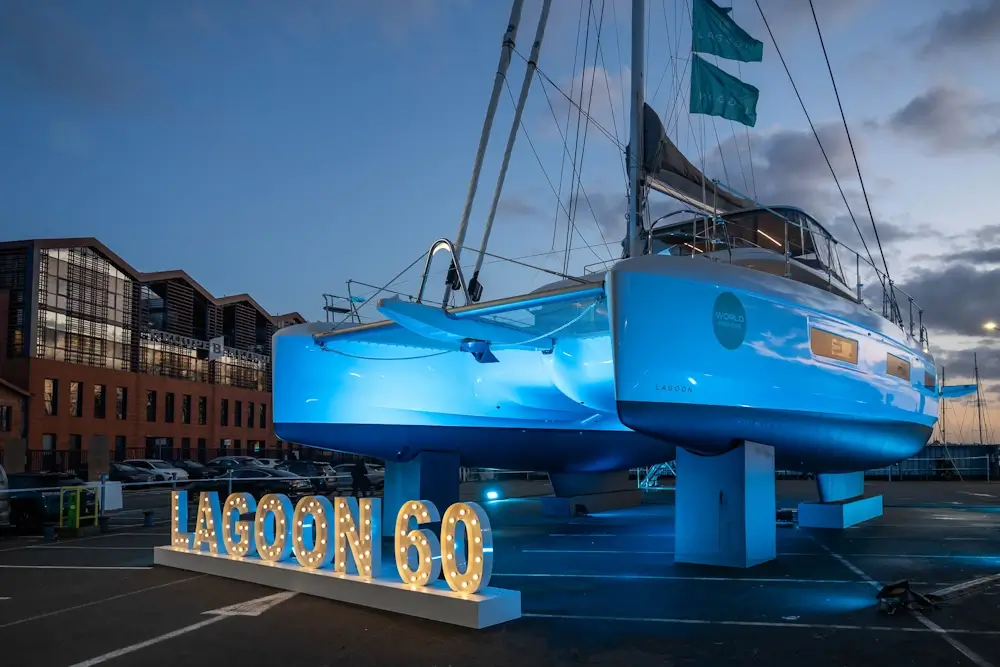
Here are some snippets from the day. With thanks to Thomas Gailly, LAGOON Brand Director, Clément Himily, CEO and Quentin Beraut, Lagoon Product Manager.
Celebrating 40 Years
2024 is going to be a big year for Lagoon Catamarans . This year they celebrate their fortieth anniversary and they’ve decided not to celebrate once but to celebrate all year long.
Two weeks ago in Miami, at the boat show they had a big party, had a great time and are now holding another one here in Bordeaux at their HQ. Lagoon is the biggest catamaran producer in the world. For the first time, they are presenting the full range from 40 to 78 feet with the entire team. It’s a big challenge. They have been organising different boats at boat shows for 40 years, but doing it during the week in the shipyard with hundreds of clients visiting: that’s something different. They have people coming from all around the world Mexico, Norway, Thailand, Sweden, France, everywhere.
Lagoon Cares
One of the drivers for the company is a desire for responsible growth under the banner “ Lagoon Cares “. Lagoon is on a mission to prove it cares about the environment, and it cares about the ways its boats are built and used.
In addition to a focus on using ever more sustainable materials, they have entered into a long-term partnership with Coral Guardian , a French NGO that aims to protect and restore coral reefs globally through the empowerment of local communities. They replant corals everywhere in the world. Lagoon is financing this NGO together with many of its clients.
Lagoon has more than 400 clients coming to see the new 60 and the whole range in Bordeaux. Some of them are Lagoon owners, some of them have their boat in build and some of them have a project of buying a boat. They want to have them talk together and get the alchemy working.

Boris Diaw, the NBA Connection
One of their SEVENTY 7 customers is Boris Diaw who won an NBA championship with the San Antonio Spurs in 2014. Boris is a great ambassador because he’s a real Lagoon user with his SEVENTY 7. Right now the boat is in Auckland NZ. He’s flying there in one or two weeks joining the boat to do the crossing to Tahiti.
Production & History

Clément Himily, CEO of Lagoon, then shared some fascinating history behind Lagoon and the shipyard.
“We have three shipyards, all in France. Two of them are in Vendee which are specialised in the production of the Lagoon 40 to 46.
Here in Bordeaux, we are focused on the production of Lagoon Catamrans above 50 feet, from the 51 to the Lagoon 78.”
“This shipyard is unique in the world for the production of catamarans of this size.”
A Strong Legacy
“There is more than 150 years of naval history here”.
“The shipyard specialised in the construction of Cruisers and tankers, but this ceased in 1985.” “Two years after, two guys, Dieter Gust and Olivier Lafourcade, founded CNB which was initially specialised in the production of large aluminium monohulls. This led to the creation of 46 unique one-off yachts building the reputation of the site including the Mari-Cha II in 1989 (Philip Briand custom), and the 117’ Hamilton II.”
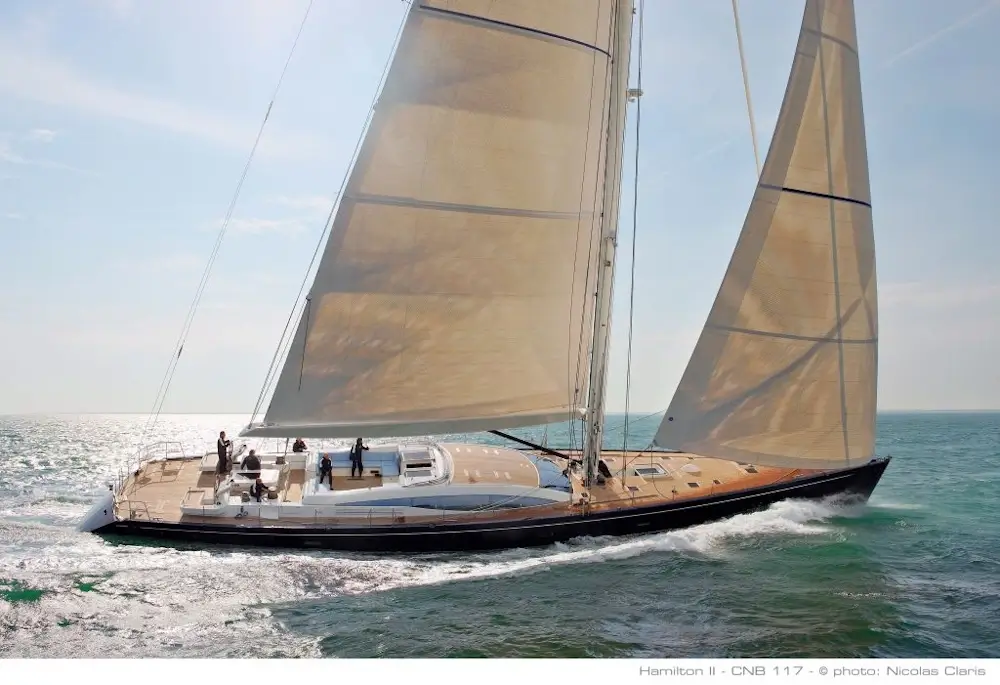
Photo Credit Nicolas Claris
“These boats were built here in Bordeaux with many of the team that is here today. That helped build the expertise of this site in the design and manufacture of large sailing yachts.”
JTA “In the meantime, in Vendee, there was a department called JTA ( Jeanneau Technologies Avancees) a legendary workshop for the development of high-tech sailing yachts. Lagoon Catamarans were quickly recognised for their single-hull and multihull off-shore racing boats.”
“JTA was specialised in racing boats, and multihulls, building very famous ones with VPLP at the design helm. Because this team was becoming very famous in the production of multihulls, Lagoon became involved in the Waterworld movie. Lagoon built the boat for the movie production team. The guy behind the wheel in the movie is not Kevin Costner!”
The First Lagoon 55
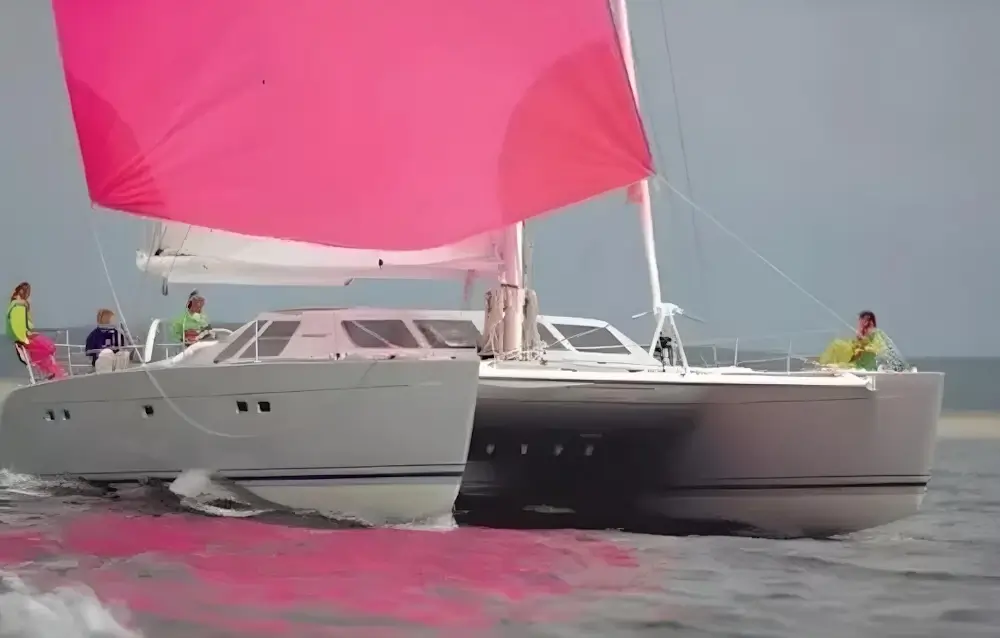
“Following our Hollywood and Hawaii episode, a lady came to us one day, a lady from Bordeaux. She wanted a one-off yacht, but not a racing boat, a cruising Multihull. She wanted to do some chartering on a big catamaran for cruising- 55 feet and in 1984 55 feet was a big catamaran .”
“We looked for a good architect, so naturally asked VPLP. Maybe they could also design a Cruising boat? This was how Lagoon built its first cruising Catamaran. The boat was a success, in charter as well and the lady decided to build another one.”
Napkin Contract “So, we thought, maybe we can develop a brand, we can start a nice story? But we needed a name. One name came out on top of the others, and it was the name that the lady gave to her first boat: “Lagoon”. We came to an agreement on the corner of the table in a restaurant, a kind of small contract on a napkin to provide some royalties if we sell a few more of them.”
“Luckily, we make a limit on that. We said that after 10 years we stop. So, that was the history!”
“Today, years later, Lagoon is a world leader with dealers everywhere and seven thousand Lagoon yachts sailing worldwide. And that’s starting from our very passionate team.”
- Marine Electric Engines: How They Work
By François Meyer | January 2024
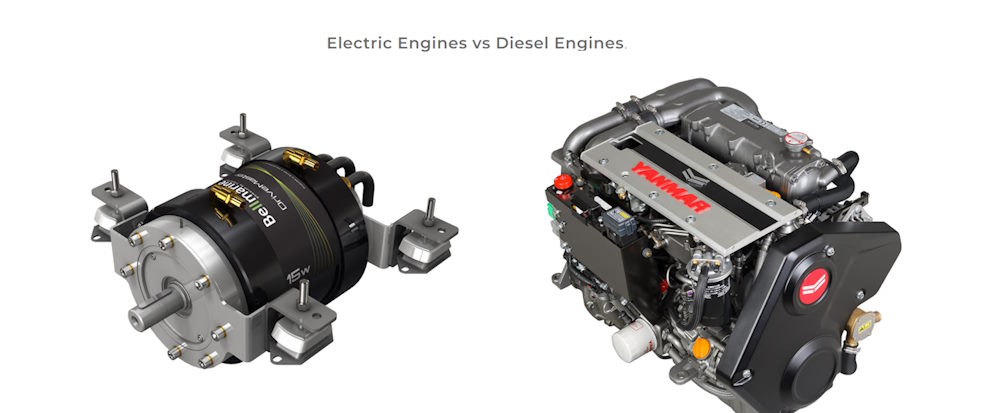
Last season’s boat shows allowed us to visit and test several electric and hybrid-electric catamarans. It is now a reality: catamarans no longer necessarily have diesel auxiliary propulsion but can be equipped with electric motors.
But how do they work and how do we compare their performance to more traditional power units? Electric, hybrid, power, voltage, charging, autonomy: there are many questions that arise from these configurations.
The aim of this article is to explain the various technologies and see things more clearly. For example, we will take a look at Electric Engines vs Diesel Engines and compare serial and parallel hybrid power systems.
Definitions
Range and Power Density Range and autonomy play a key role within cruising catamaran capabilities. Diesel delivers a huge range because of the high power density of this fuel.
For diesel, one 20 litre jerrycan of diesel (25 kg including the can) contains 204 kWh energy, which is very substantial compared to a battery bank. If you wanted to store 204 kWh energy in a battery bank, it would weigh more than 1200 kg.
The high power density of fossil fuels is one of the main reasons for the dependence of the industrialised world on this fuel. Conserving power within batteries costs a lot of weight and money and requires powerful inboard charging.
Diesel Engines
Because of the high power density of fossil fuels used in combustion engines, the efficiency of diesel ones, was not such an important consideration, especially in boating.
The average overall efficiency of a diesel engine rarely goes beyond 40%. It means you “lose” around 60 % of fuel within the process. Lots of internal mobile parts generate friction and heat which is the main loss.
Furthermore, most catamarans use saildrives. This transmission choice, saves space inside the hulls, but comes with around 10% more losses (gears) compared to a shaft drive.
So at the very end of the day, from an energy point of view, a catamaran fitted with diesel saildrives is not very efficient.
Efficiency of Diesel Engines

Electric Engines
On the other hand, there are not as many moving parts in an electric engine that uses a low friction magnetic field to operate. Their overall efficiency is much higher, higher than 90% in the case of the Permanent Magnet electric motors used in marine vessels.
Better efficiency means also avoiding waste! For that reason, most newbuild catamarans are choosing shaft drives, not saildrives, to achieve better overall efficiency. Electric saildrives, like Oceanvolt Servoprop, are mainly designed for saildrive designed boats whose bilges are simply too small to receive a shaft.
Efficiency of Electric Engines
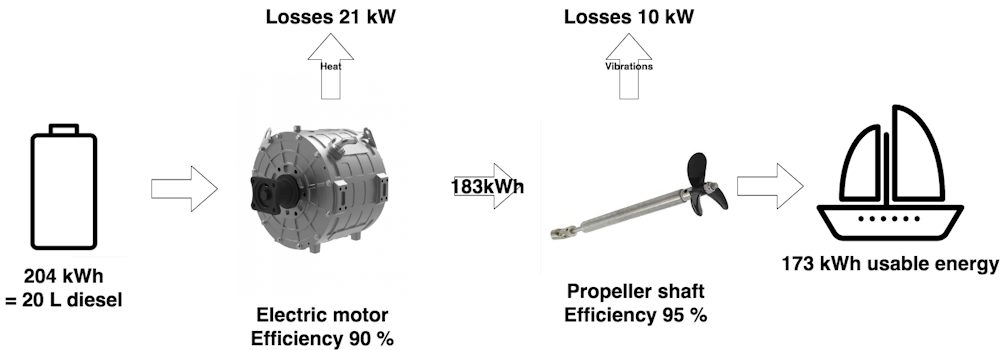
Downsizing : Diesel and Electric Power Engine Comparison
You may have already noticed this, but electric catamarans are commonly fitted with engines whose power rates well below diesel ones. Firstly there is the conversion factor between horsepower and kilowatt. This is just maths, as 1 kilowatt (kW) is equivalent to 1,36 HP.
The big difference is in torque availability. A diesel engine has its nominal power and torque (the ones that are advertised) at high RPM, at a much higher speed than an engine should be used.
On the graph below, we see power and torque of both diesel and electric engines. For a traditional setup, the power is represented by the dark purple curve at high RPM of a diesel engine (max at 3200 RPM).
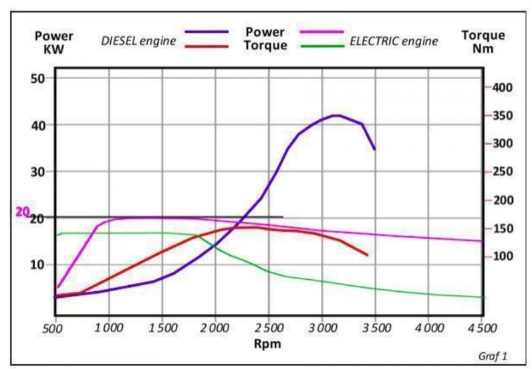
If we look at the light purple curve (electric engine), this shows the power of an electric motor is almost constant, after starting.
Let’s now have a look at the torque curves. Torque is the force which turns the propeller and propels the boat.
At 1800 RPM, both motors benefit from 100% of their torque. To achieve 150 Nm of torque, the electric motor needs only 20 kW while the diesel requires 42 kW!
The combination of high torque-low RPM and better overall efficiency mean that you can downsize electric engines when compared to diesel ones. The downsizing sits between a factor of two and three.
System Tension
One of the basic rules of electricity involves the relationship between power, voltage and current.
Power (W) = Voltage (V) x Current (A). The higher the voltage is, the lower the current. Lower amps means, on a boat, smaller diameter cables. But higher voltage also means lethal danger.
There is a physiological limit for a human being (above 120V DC): the heart can be stopped by electrical shock. In wet conditions, this limit goes to 60V DC. That is why most hybrid catamarans are wired at 48V, well below 60.
Some boatbuilders, like Fountaine-Pajot with the Smart Electric Series (Aura 51, Elba 45…) use a 400V DC setup. It is a boatyard choice, but only very educated and skilled tradesman will work on such systems when any marine electrician will be happy to work the more common 48V system.
Electric, or hybrid?
Electric catamaran An electric catamaran is a vessel whose principal propulsion is provided by the wind and whose auxiliary propulsion is provided by an electric motor. On board a 100% electric catamaran there is no combustion engine and no other energy than electricity.
There are not many 100% electric catamarans around as their range, dependent on battery capacity and onboard chargers, is too low for cruising.
The story of Jimmy Cornell’s Outremer 4.Zero is interesting as the renowned sailor decided to go, against the will of the yard, with a full electric (ie. not carrying a diesel genset). In the end, power consumption and power production were not in balance and the fossil free circumnavigation project failed. Relying only on a small sized solar panel array (1,3 kWh) and relatively inefficient regeneration, the boat’s energy consumption was simply too high.
On that boat, fitted with 2 x 10 kW Oceanvolt Servoprop saildrives and 17,5 kWh of batteries, the range, motoring, at mid RPM is less than two hours. Regeneration was delivering around 300 Wh, (0.3 kWh), too few to refill the batteries while using all of the electric appliances.
Hybrid Catamarans A hybrid catamaran is a vessel whose principal propulsion is provided by the wind and whose auxiliary propulsion is provided by different means including an electric engine. Its system uses two or more power sources on board.
Hybrid catamarans can be equipped with an auxiliary main diesel propulsion, assisted by a secondary electric one (parallel hybrid or bi-motorization), or with auxiliary electric engines relying on batteries that can be recharged under way by a generator (diesel, hydrogen, methanol), ie a serial hybrid. This greatly increases the range.
Because of the requirement for a good range, most of the so-called electric catamarans like the Windelo 50, HH44, Fountaine-Pajot Smart Electric Series, O-Yachts Class 66 Eco are hybrid catamarans.
Serial Hybrid Catamarans

A serial hybrid catamaran is propelled by two electric motors. Those motors get their power from batteries which are being charged while sailing using various means.
Solar (photovoltaic) panels account for an important share of renewable energy in the energy mix. Hydrogeneration does not depend on light and can deliver power at night, when sailing a passage.
Serial hybrid catamarans always have a back-up power generator to fill the batteries when needed. The generator can be diesel, or in the future hydrogen, ammonia or methanol (fuel cells).
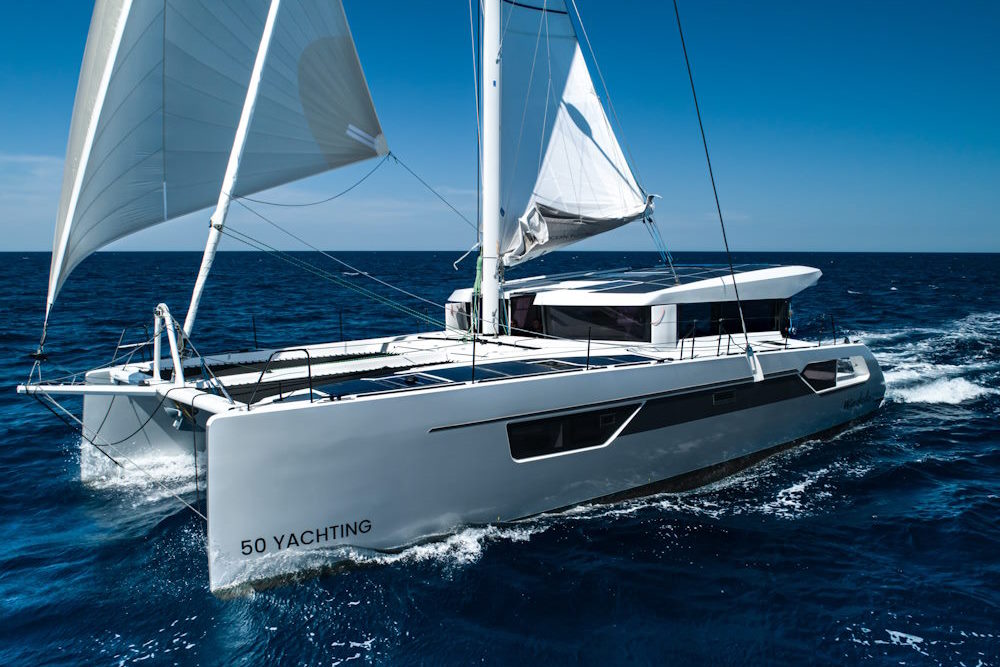
The Windelo 50 is probably the most efficient serial hybrid sailing catamaran on the market.
Light and fast, she sails well and her two 20 kW electric engines with shaft drive deliver the best efficiency possible. Wired in 48 VDC, with 53,8 kWh of battery capacity (propulsion, 6 kWh house bank), the boat boasts a 5,5 kWc photovoltaic array.
Under sail, on a passage, the boat produces enough power to cover its consumption and slowly charges its batteries. Solar gives her between 20 to 30 kWh per day (depending on latitude) and hydro regeneration, around 24 kWh per day when sailing 10 knots.
But, if needed, the generator can be started, delivering 17 kWh to the battery bank to replenish it within hours. Or, if they are empty, to provide 6 knots motoring speed, the genset is used.
Combining those three methods of charging, the yard claims a 1100 NM range, which is twice the range of a Lagoon 42 with its two 57 HP diesels.
Nevertheless, the Lagoon 42 still has the advantage of power as it can increase its RPM when motoring against waves and tide to cruise at 7 knots while burning more fuel. The Windelo cannot do that, and, in such conditions, its motoring speed will lower.
The Lagoon retains a second advantage as if one diesel fails, the boat still has the other to motorsail.
If Windelo loses its genset at night with depleted batteries, she will have to rely on her sails. Some owners choose a 2 genset configuration for redundancy, but that does add weight and cost.
Parallel Hybrid Catamarans
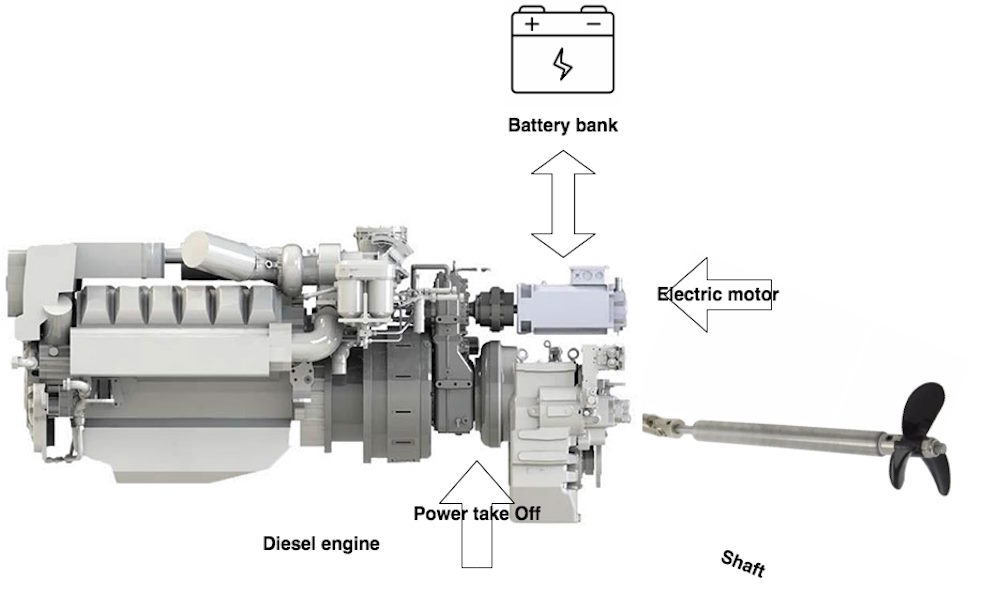
This set-up uses an electric motor mounted on the diesel engine, both capable of moving the propeller. Where the serial hybrid has two functions (moving and regen), the parallel has four.
The diesel engine can propel the boat. While doing that, it can also move the electric engines which will produce some power, acting as a generator.
The electric engine can move the propeller, diesel off. And, in emergency cases, both electric and diesel engines can move the prop, in a kind of boost mode.
The parallel hybrid yachts do not need any generators as their engines behave as powerful ones. This setup fits particularly well for cruising catamarans as you can enjoy the joy of silent sailing or electric motorsailing but you can always rely on your trusty diesels if needed.
The two systems do not rely on each other and offer an interesting case of redundancy.
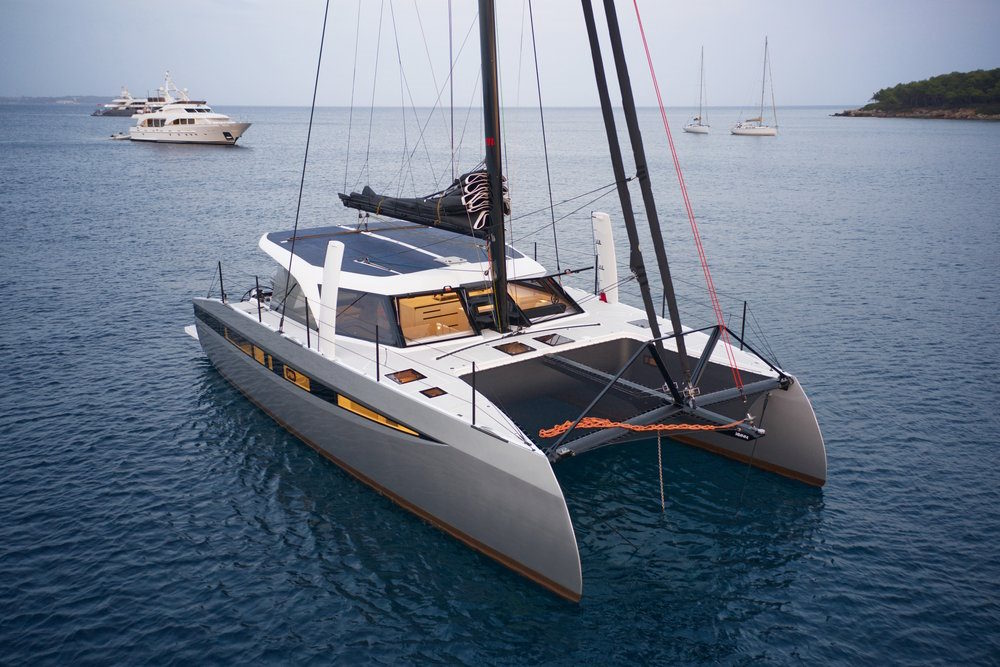
A catamaran like the HH44, charges 5,4 kWc from solar and has two 30 HP diesel + 2 10 kW electric motors using a 43,2 kWh battery bank. While diesel motoring, the boat delivers 10 kW to charge the batteries. A sunny day can also fully charge the bank.
Those 43,2 kWh can propel the yacht at 6 knots for a couple of hours. Total range (diesel) is around 628 NM, according to the yard, a range which comes with a good dose of redundancy.
Bi-motorised hybrid catamaran
This third hybrid mixes 2 independent propulsion systems, a diesel one and an electric one.
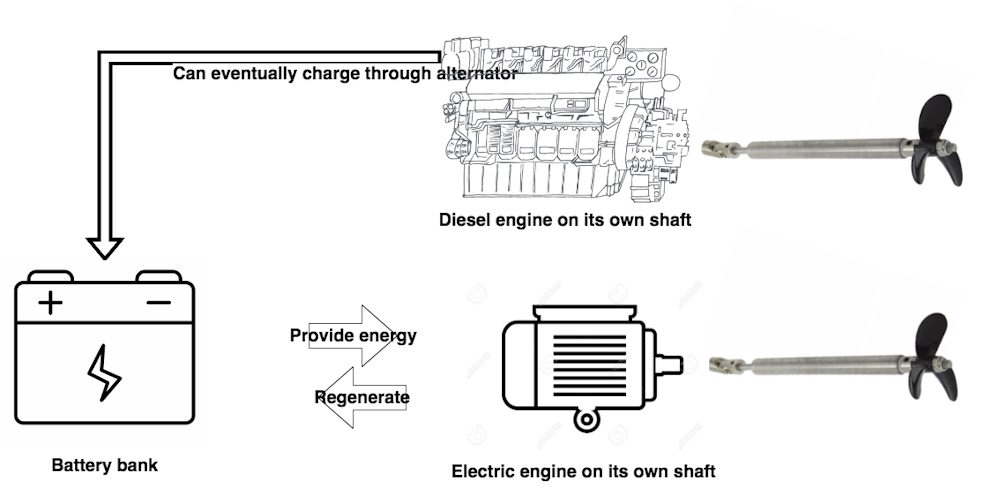
O-Yachts offers, in its Class 66 Eco, a bi-motorised setup for example. One hull has a conventional diesel with shaft and the other an electric engine with a shaft-drive.
As the two systems are totally separated, the redundancy is there. The boat can be sailed with one engine, diesel or electric, and a small 5° rudder correction will drive the boat straight. Diesel alternator, regeneration and solar replenish the batteries.
This setup, although interesting, suffers from a disadvantage. As the two engines are different, they behave differently and this can cause issues manoeuvring in the marina. The skipper will need plenty of experience in different conditions before fully mastering the boat.
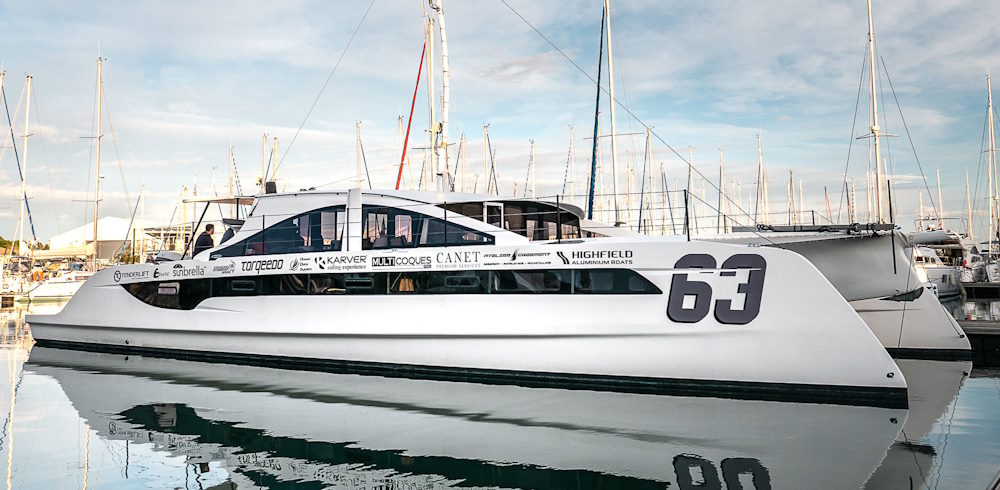
- Windelo Catamaran Partner with Just Catamarans
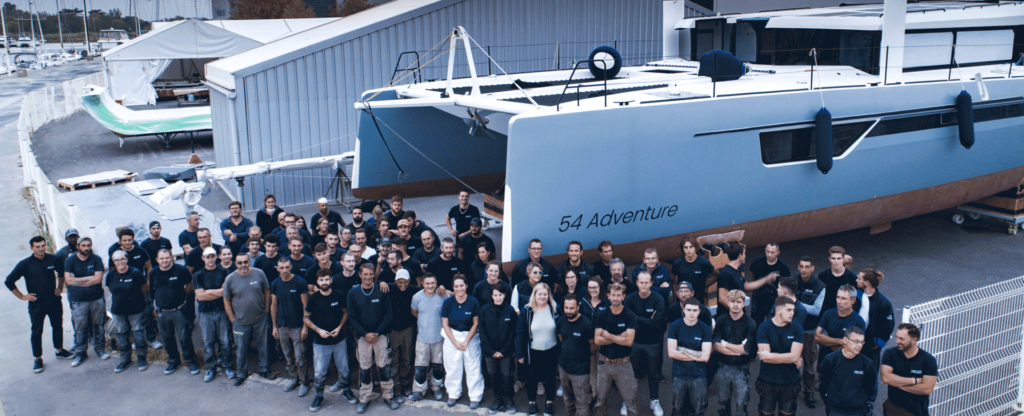
Windelo Catamaran and Just Catamarans have announced a Partnership for USA Sales & Services.
Windelo Catamaran , based in Canet-en-Rousillon in France, build advanced eco performance catamarans. They have teamed up with Just Catamarans who are based in the US, primarily at their Fort Lauderdale hub.
The Windelo designs are proving popular in the North American market, and Just Catamarans will help the French manufacturer to drive growth of Windelo Catamaran in the US market through their experience in the performance cruising segment.
The new partnership will be officially launched at the International Miami Boat Show with the New Windelo 50 premiering in the US and building on the successful development of the brand in Europe.
Designed in collaboration with the architects Christophe Barreau and Frédéric Neuman and designer Charlotte Schiffer, the New Windelo 50 is a performance blue-water ECO cruising catamaran with an electric propulsion system and a pioneering hull construction method that uses volcanic basalt laminates, a more sustainable alternative to traditional fiberglass matting.
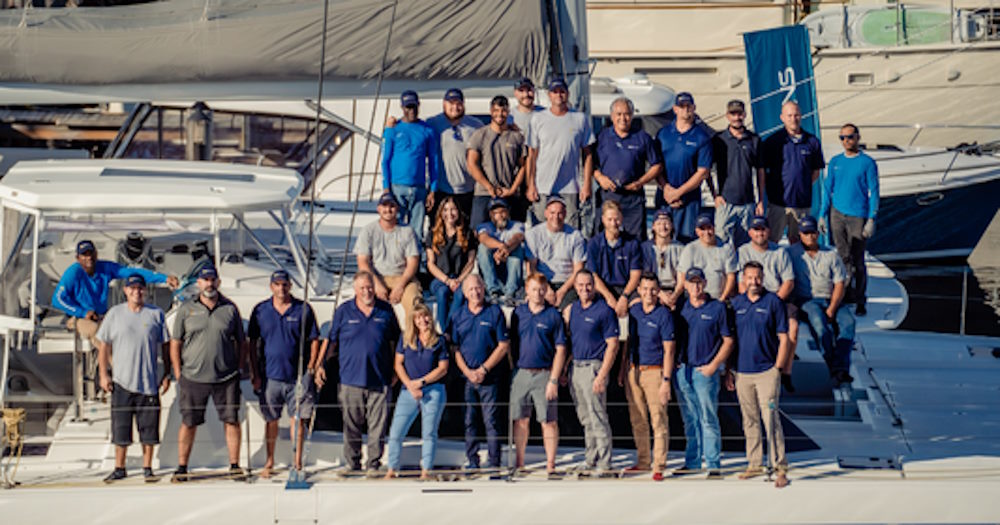
Feedback from the New Partners
Thoughts from Just Catamarans: “Our entire team looks forward to working with Windelo,” says Thomas Chambers, President of Just Catamarans Sales. “Representing a bespoke brand of performance multihulls that focuses more on sustainability and introducing electric-hybrid propulsion in this market is exciting for us and our clients.”
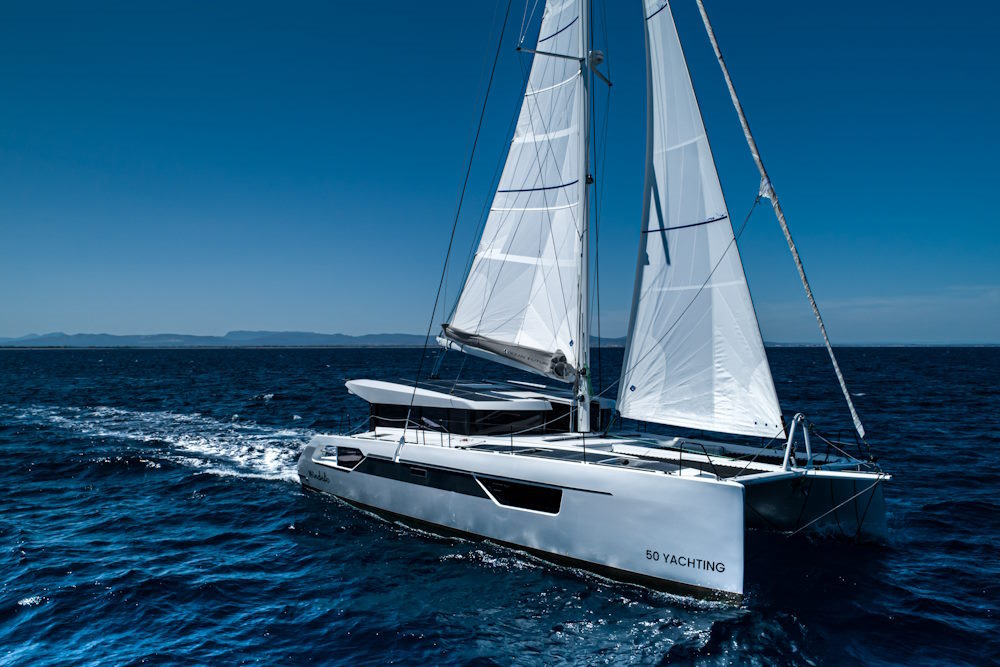
Thoughts from Windelo: “We are absolutely delighted to welcome Just Catamarans aboard the Windelo family, » said Gautier Kauffmann, Windelo’s Founder.
“The reputation of Just Catamarans in the US and their expertise in developing and supporting high-end-performance cruising multihulls will be an undeniable strength for the development of Windelo in the US market.”
“Just Catamarans will be a key partner to the service footprint for all our clients visiting the US & Bahamas with a Windelo”.
“Whilst Just Catamarans will boost the visibility and service of our brand in the territory, we understand how important it is for our customers to maintain direct contact with the shipyard throughout the lifecycle of their boat. This is why, together with Thomas’ team, we have set up a partnership that adds up our teams in a joint approach to Sales & Servicing of our owners’ catamarans.”
- Excess Campus
One of the areas in which Excess Catamarans is working hard to stand out from the crowd is their desire to connect and build relationships with owners and prospective buyers.
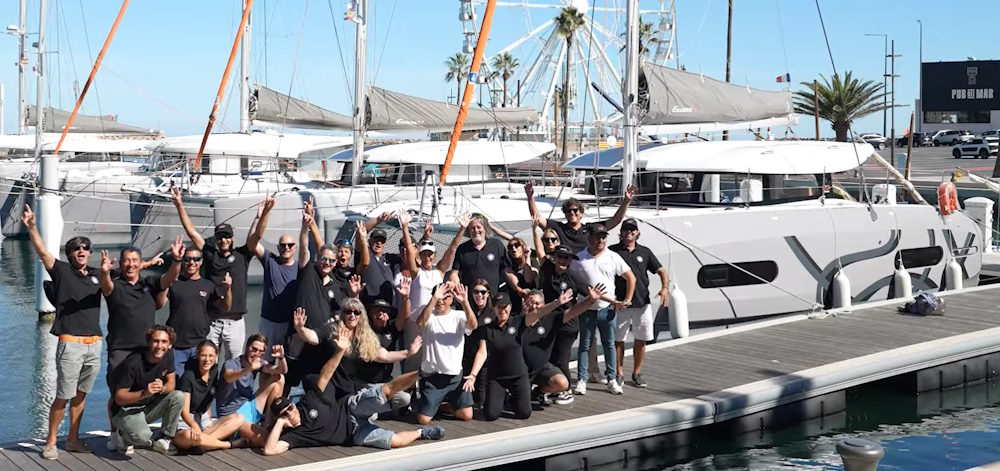
This approach seems to be paying dividends – it’s helping them develop their boats with direct feedback from customers and helping people to navigate through the complex process of buying and kitting out a new catamaran.
The end result? Skilful sailors with new friends having fun out on the water.
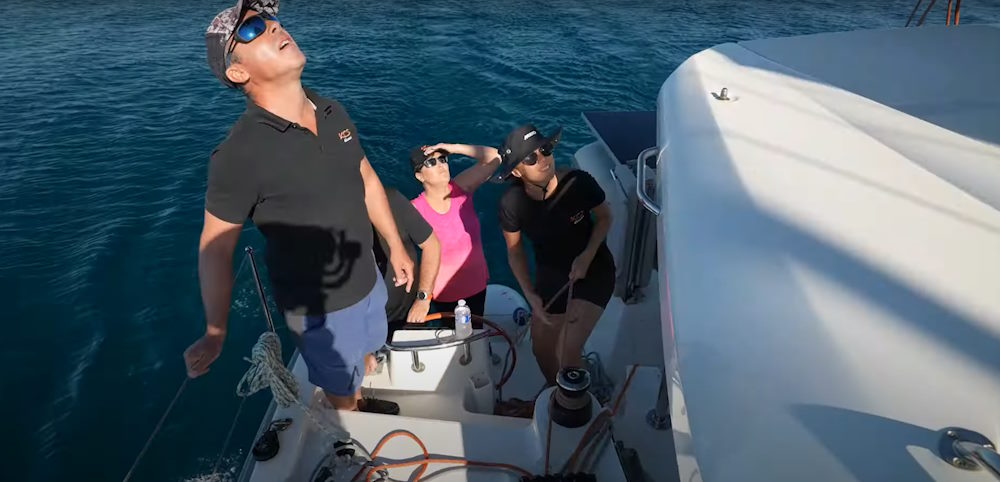
Excess Campus 2023
Just recently, the team ran the first Excess Campus of 2023. This event, organised by Excess Catamarans, a brand of the Beneteau Group took place in Canet-en-Rousillion near Perpignan in France, and was a series of workshops and seminars that aim to help customers learn more about topics such as predicting the weather, navigation, boat maintenance, safety, and lifestyle on board.
There were 21 owners involved (a mix of English & French speakers) for 3 days of theory and practice to learn all about maintaining an Excess and the must-have tips for sailing.
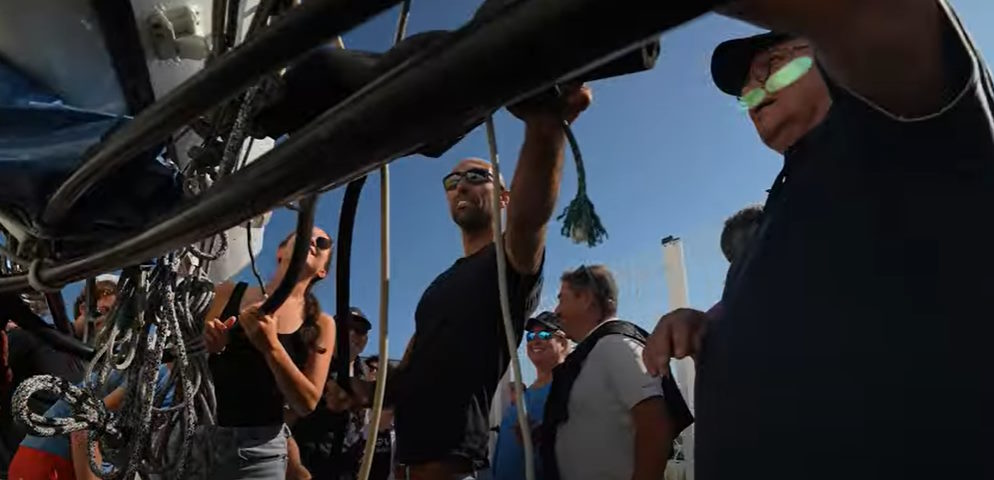
And of course, the event had a substantial social side, enabling owners and buyers to mingle with other enthusiasts from around the world.
The event is all about learning, sharing, and having fun, a course for experts and novices alike who want to discover the joys of sailing and living on a catamaran.
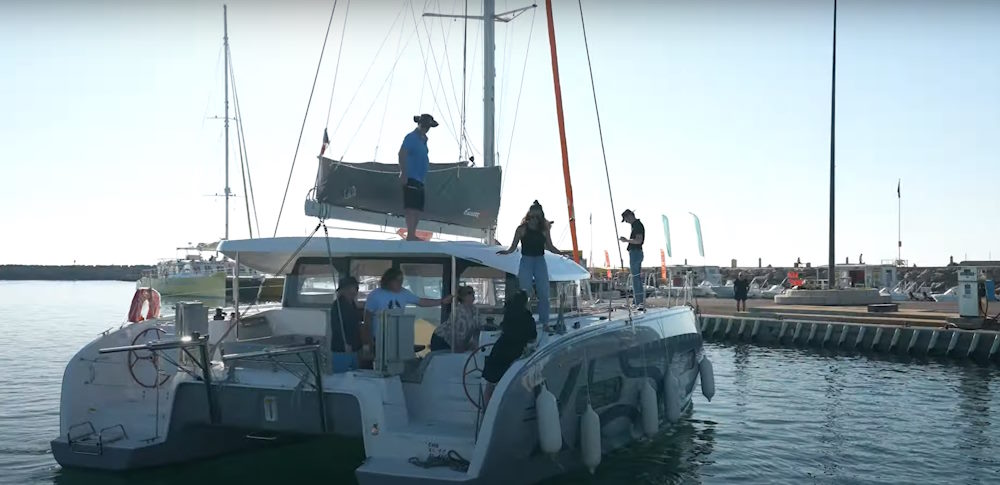
Some of the topics covered were:
- Navigation: how to plan your route, use the instruments, read the weather, and handle the sails and engines.
- Boat maintenance: how to check the systems, perform routine tasks, and troubleshoot common issues.
- Safety: how to prepare for emergencies, use the equipment, and communicate with the authorities. This includes a session with SNSM: Les Sauveteurs en Mer, whose raison d’être is saving lives at sea around the French coast, including the overseas départments and territories.
- Lifestyle: how to organise the space, store the supplies, cook the meals, and enjoy yourself on board.
- Boat Handling – this is probably the most popular part of the course – hands-on training on an Excess catamaran perfecting skills such as docking, anchoring, picking up a mooring buoy, raising and trimming the sails and more.
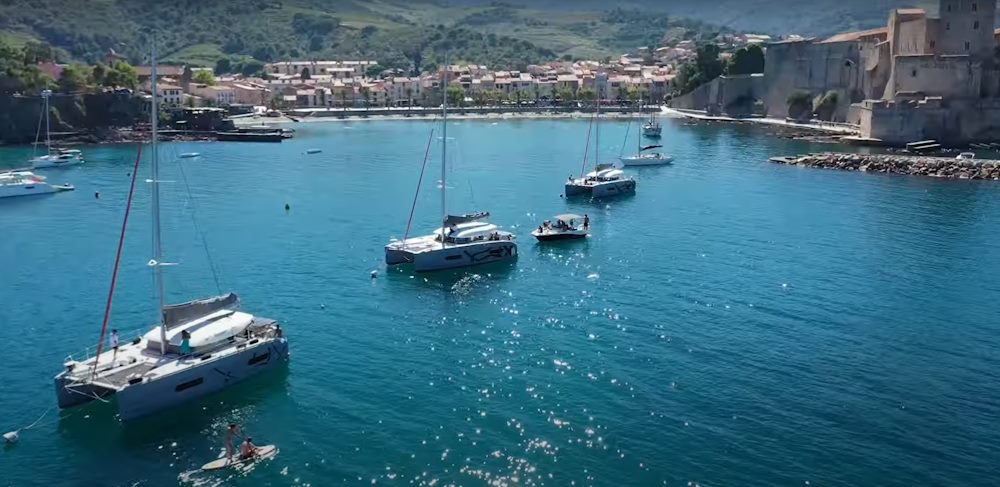
Following the success of the 2023 edition, Excess is already planning the 2024 edition of the Campus, so stay tuned!
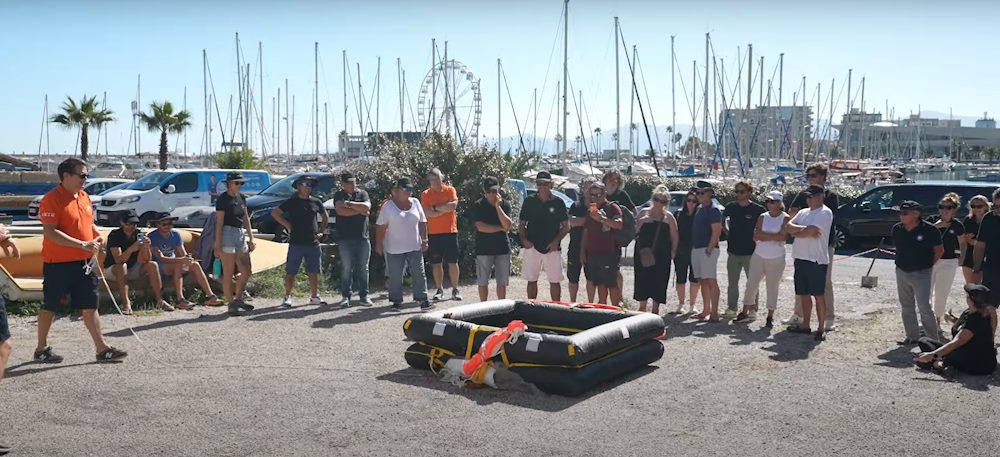
Excess Campus 2023 Video
Here’s the summary of the event!
- Lagoon Update, Oct 2023
Lagoon has been designing and building catamarans for almost forty years. They will celebrate their 40th anniversary in 2024. We met up with the management team to talk about Lagoon and their plans for the future. Their mission is to remain the world leader, building boats for their customers that are safe, reliable, comfortable and that can travel the world with a respect for the environment.
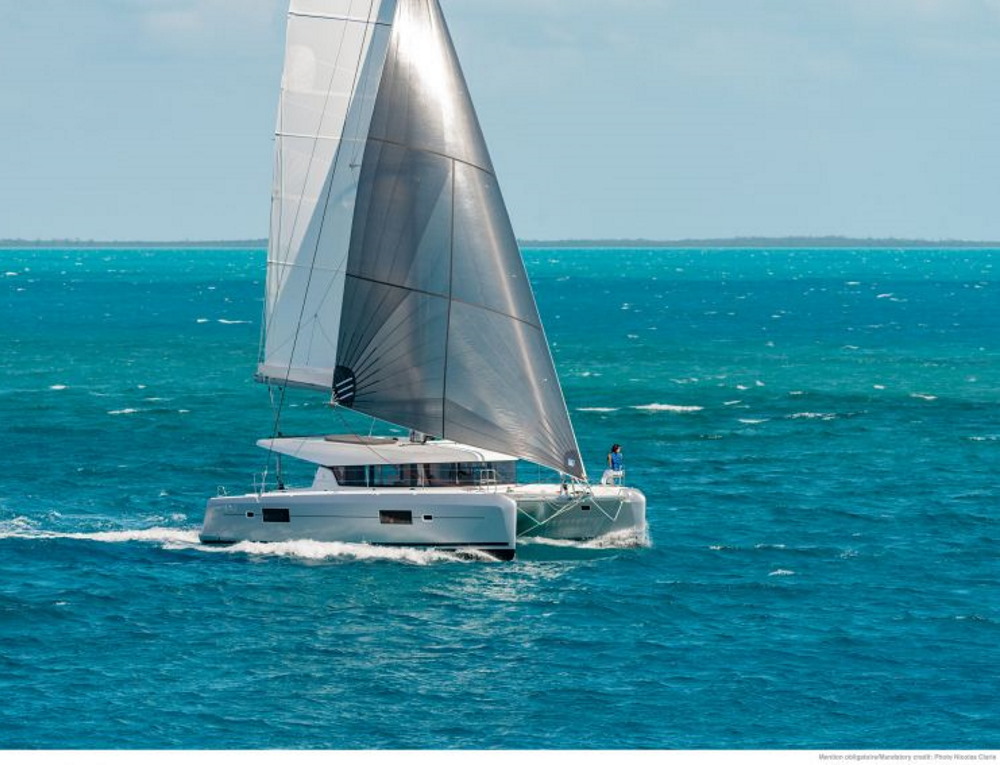
Lagoon shared some remarkable numbers at the Cannes International Yachting Festival.
First of all, with the 51 and 55, the last two new models, they have reached a milestone in September 2023 of 250 units sold. Both boats are built in Bordeaux, where they are increasing production capacity. And in August they delivered the 500th Lagoon 46 to Australian clients.
What is the Top Seller Ever in the Sailing Catamaran Market?
It used to be the Lagoon 380 which was later overtaken by the 450. Now the best-seller, the world champion is the Lagoon 42. In October 2023 they will deliver the 1000th Lagoon 42 to French owners who joined them for the party on Friday night in Cannes.
And more than forty-two Lagoon SEVENTY are sailing worldwide with orders to come, a much bigger number than Lagoon was expecting in their initial business plan for this luxury market segment.
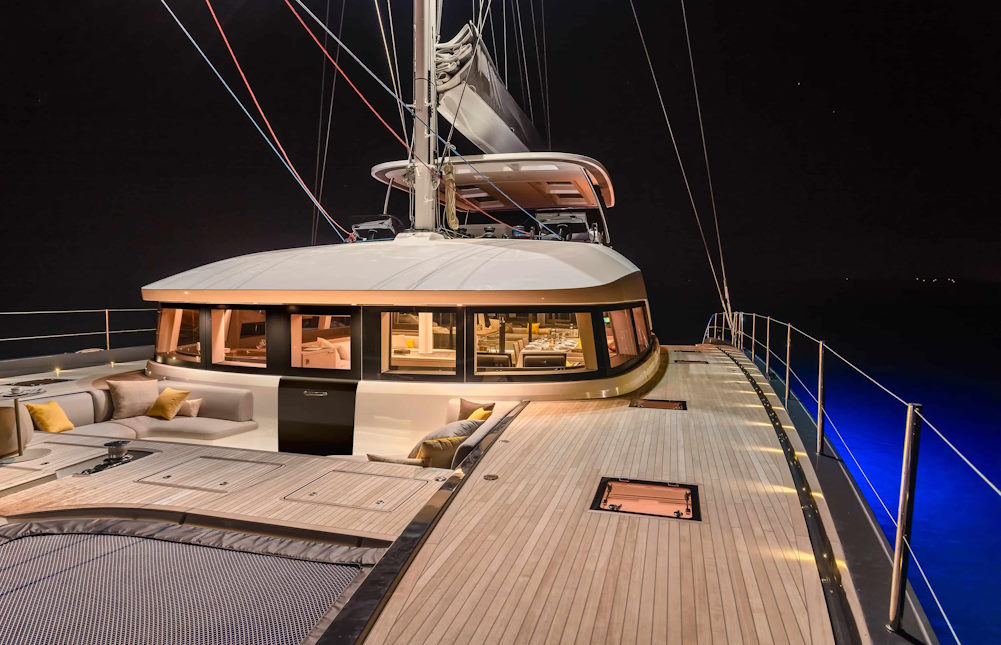
Every year, Lagoon shows a SIXTY & SEVENTY at the Cannes Yachting Festival and every year the boat is different: these are fully customised yachts. They have a dedicated team for this luxury market segment, working closely with the captains and crew to continuously optimise the boat.
The luxury charter segment has been very successful, with these yachts commanding a one-week charter price of between $70k to $80k in high season.
7000 Lagoons Sailing

In the coming month, Lagoon expects to hit another milestone: seven thousand Lagoons sailing worldwide. Their ambitious goal is to be in touch with all of these owners through the Club Lagoon with a lot of services for all clients. This is a key service they want to develop over the coming years.
With the SIXTY and SEVENTY, each boat has a dedicated after-sales team, a point of contact, direct with the factory and owners can follow the construction of their boat online.
1) Customers have direct contact with Lagoon’s SIXTY 5, SIXTY 7, SEVENTY 7, SEVENTY 8 Specialists: a Premium Service 2) They follow their boat in production 3) Customers have a dedicated after-sales team
Lagoon Furling Boom

One of the latest innovations to be offered on Lagoon catamarans (46′ and 51′) is the mainsail furling boom. This has been developed by the Lagoon team with Incidence Sails and Groupe Wichard.
One of the main advantages of the Lagoon system is its simplicity: the furling spindle is not enclosed in a housing, so it is easy to monitor and control hoisting, reefing and furling manoeuvres. And it’s lighter than a standard set-up.
To use it, the main sheet must be eased, the topping lift employed, you must be headed into the wind (or at least a 30-degree TWA), and you must keep a fair tension on the luff while adjusting the sail. The system has been thoroughly tested over 2 years and has proven to be very reliable. On the 46 and 51 which have the flybridge, this system makes a lot of sense with their higher booms. This will help owners to use their sails more often.
This is an exclusive system, installed by Lagoon and covered by their warranty.
Reducing their Footprint: Lagoon – Awarded ISO 14001
What Is ISO 14001? ISO 14001 is a set of standards from the International Organization for Standardization (ISO).
It aims is to define the best practices for organizations that wish to reduce their environmental footprint by adopting an effective environmental management system (EMS). They have also been awarded ISO 50001, a standard intended to help organizations develop and implement an energy management system.
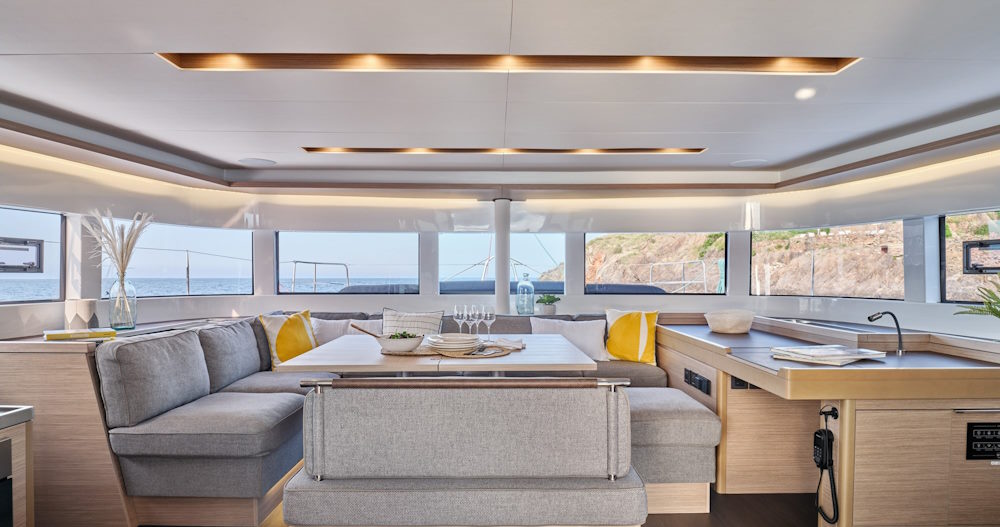
What does this mean in practice? The resin used on Lagoons is becoming more and more bio-sourced, the kitemark looks at the raw materials that Lagoon uses, with a target to use 100% recycled materials on the upholstery and work on using recycled materials for the sails continues.
Hemp fibre is replacing fibreglass in many panels on the boats. They are replacing teak with a new type of wood from sustainable forests. A water purification system will be installed on all Lagoons, helping people to move away from water in plastic bottles as you can drink the water from the tank.
Lagoon delivers with every boat launch a pack of eco-friendly cleaning equipment, to help educate clients on the best eco-friendly products that are available in the market.
Other areas they are working on include black water treatment, solar panel efficiency, wind turbines, hydro-generators, and more efficient A/C.
They continue to test electric power and hybrid power extensively to develop a system that is very reliable and safe.
The Future is Bright
So, the future is bright for this market-leading French catamaran manufacturer and they continue to grow responsibly across many different market segments.
We are looking forward to seeing the new Lagoon 60 on the water in 2024, the year that they celebrate their 40th anniversary. The next target? 8000 yachts on the water, all active members of the Lagoon Club!
- A New Excess Catamaran in 2024!
One of the big announcements at the 2023 Cannes Yachting Festival was from Excess Catamarans who announced a new addition to their range of sailing yachts. The new model will slot in between the Excess 11 and Excess 14.
Helping them on the next stage of development of this increasingly popular brand will be Lombard (MLYDG) – in charge of the naval architecture and Jean Marc Piaton who will design the interiors. Following the Excess Catamarans philosophy, this will be a collaborative process involving the Excess team and the “Tribe”: their owners, clients, dealers and industry experts. We are looking forward to seeing the design in more detail in early 2024!
Building on the Success of the Excess 14, shown below:
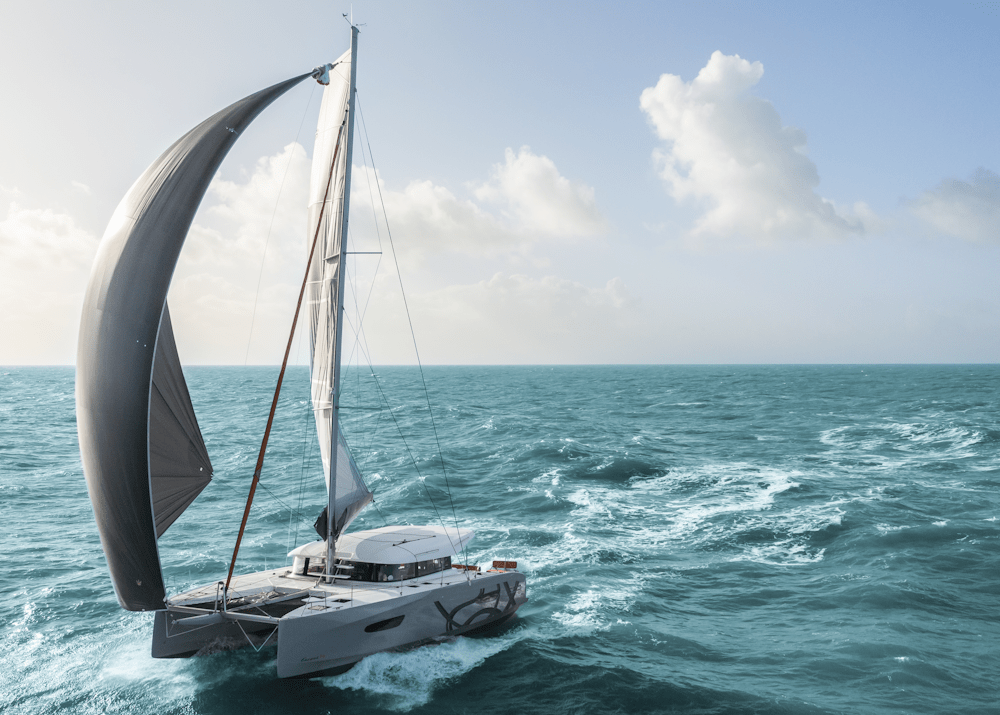
The Next Generation
These two experienced design teams will evolve the design from the Excess 11 and 14 which were created with VPLP design and Patrick Le Quément for the first generation of Excess catamarans.
The brief for the designers is to build on the brand’s strengths by creating a catamaran that’s fun to sail and comfortable to live aboard. It’s this balance and a growing reputation for after-sales and relationship building that has defined the essence of Excess so far.
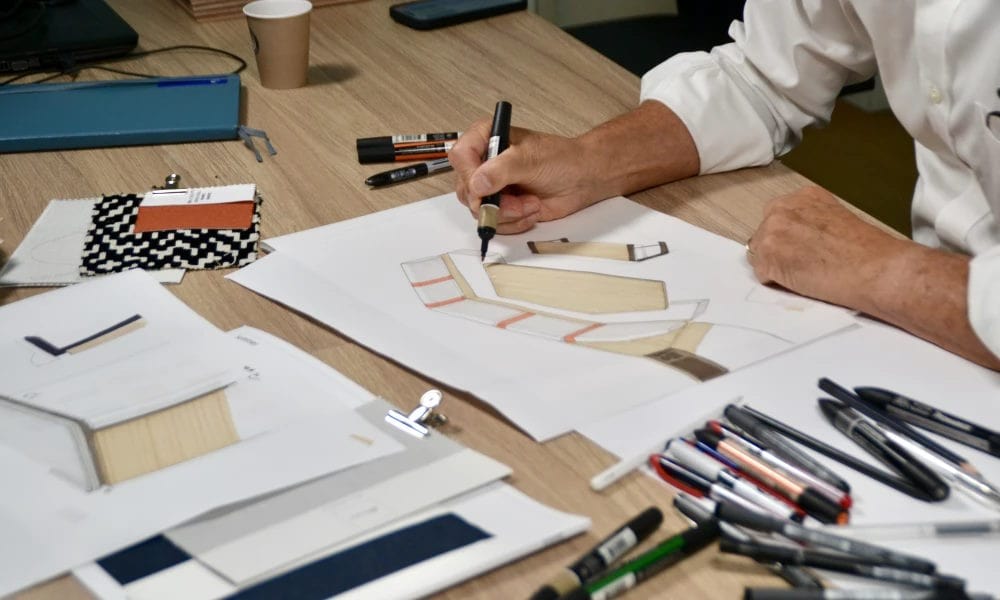
Marc Lombard Yacht Design Group
A word from Eric Levet, Marc Lombard Design
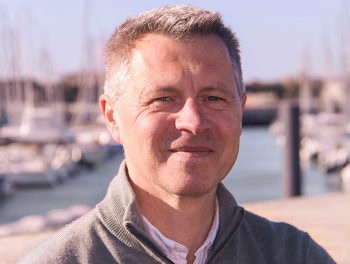
“For the Lombard team, integrating the Excess Catamarans brand with this new project is a challenge we’ve been delighted to take on!”
“In partnership with the Excess design office, we were keen to develop the design of this new catamaran to reinforce the brand’s strengths.”
“The brief was simple yet ambitious: to create a catamaran that’s evolving and balanced, solid, and offering great sensations, all combined with the comfort and interior volume that has made Excess such a success.”
“The form of the hulls, the weight, the composite structure, the layout, the ergonomics, the efficiency of the sail plan, everything about this new Excess is designed around the pleasure of easy sailing and comfortable living on board.”
“Following several months of design and rewarding exchanges with the Excess team and Jean Marc Piaton, we’re taking the time to refine the design in detail and in manufacturing optimization. We can’t wait to see the boat sail!”
Jean-Marc Piaton
A word from Jean-Marc.

“We heard from around thirty people who spoke to us about the brand (in-house people, dealers, owners, and charter companies, among others), and what emerged was a very positive and, above all, highly identifiable perception.”
“This is both very rare for such a young brand, and very interesting when considering its design.
Hervé Piveteau, Product Manager at Excess, had high expectations of lightness, both real and perceived, and wanted this new model to fit in well with existing models, without creating too strong a break.”
A New Model in 2024
We’ll keep you posted with the latest news on this new model.
In January 2024, at the Düsseldorf boat show, Excess will be revealing the name and the first 3D images of the new yacht.
- New Windelo 50
The Windelo 50 has recently been upgraded with a fresher, sleeker look and a further upgrade of sustainable energy.
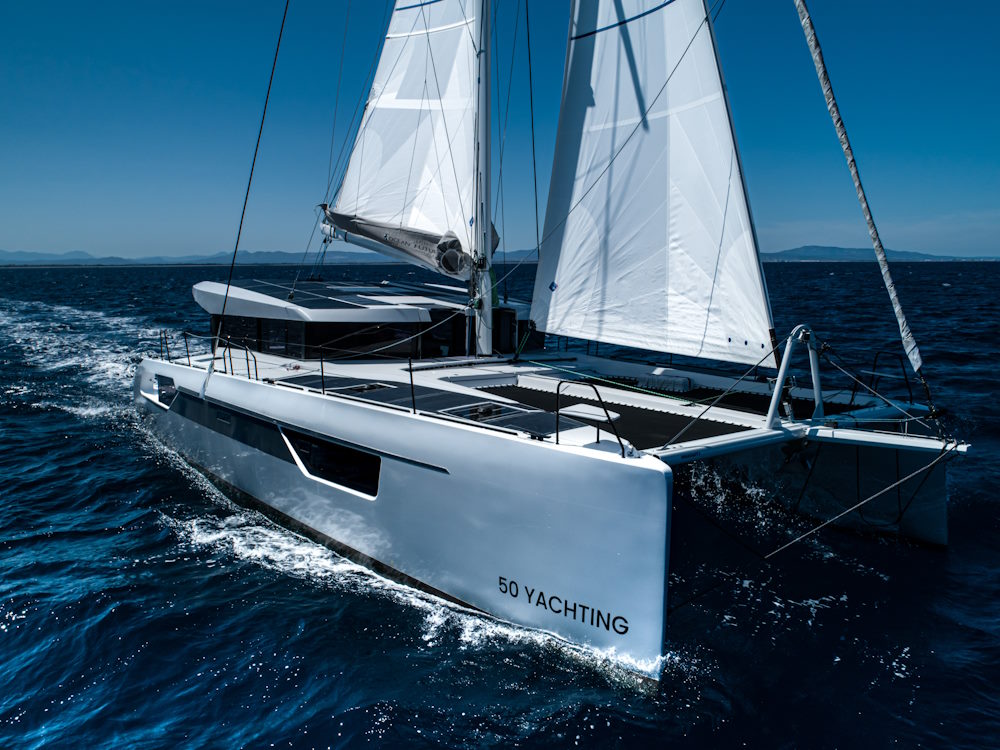
The first of the new catamarans, a 50 Yachting, splashed in July 2023 and will be making an appearance at the Cannes Yachting Festival in September 2023.
Katamarans.com are joining the Windelo team on their delivery trip from the Windelo Base in Canet-en-Rousillion near Perpignan, capital of the capital of Pyrénées-Orientales region, to the Côte d’Azur. We can’t wait to see the new design in action firsthand!
The New Windelo 50 has had a substantial design upgrade thanks to a team effort from her naval architects (Christophe Barreau and Frederic Newman), designer (Charlotte Schiffer), and the Windelo engineering office.
The new design represents a move upmarket, with upgrades to the decks, superstructure, and roof and a reworking of the layout.
Full Windelo 50 feature .
Even More Solar
The New Windelo 50 design accommodates even more solar on a longer roof without compromising on weight thanks to the simplified composite assembly manufacturing process. And this ECO yacht now boasts a racy, stylish look.
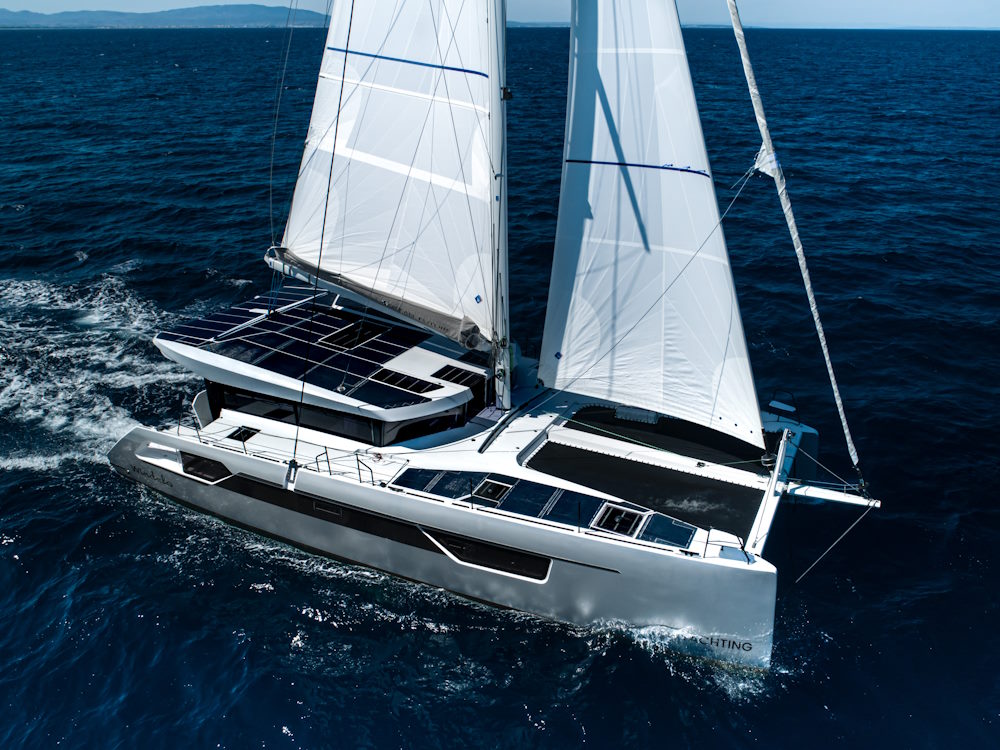
The aft deck has been enlarged to provide a more comfortable living space, even better protected from the sun and weather.
The New Windelo 50 Yachting can now accommodate up to 5,680 W solar panels for even greater autonomy and zero emissions while motoring on her electric engines.
Launching at Cannes Yachting Festival
The Windelo team will be presenting the New Windelo 50 Yachting at the Cannes Yachting Festival from September 12 to 17. We’ll be closely covering the show and the trip to Cannes on the Katamarans network, so stay tuned for more information from the passage!
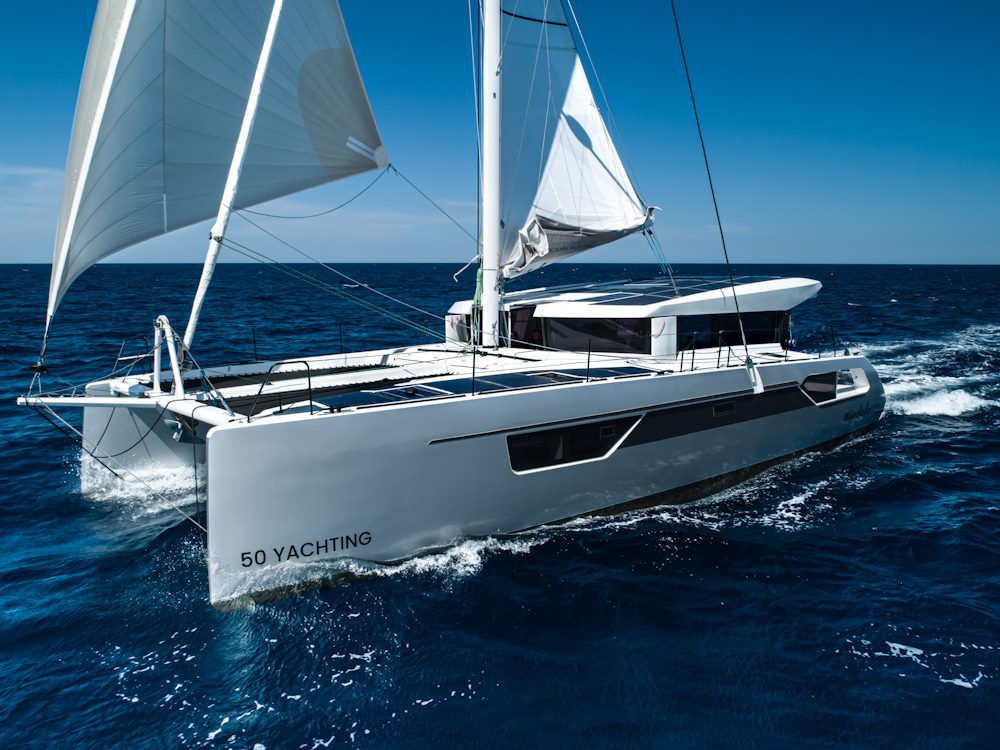
Key Features
- The Windelo 50 is manufactured from an innovative environmentally-friendly composite sandwich consisting of Basalt fiber and PET foam from recycled plastic bottles, reducing the boat’s carbon footprint by 47%.
- Two electric motors, 5,680 W solar panels, and a hydro-generation system that recharges the battery bank every day provide up to 4 hours of autonomy using solely green energies when motoring at 6 knots.
- A forward cockpit at the foot of the mast centralises all catamaran manoeuvres. The new cockpit can be completely closed, so you can sail close to the action, protected from the elements, whatever the weather. A nacelle offering incredible interior/exterior modularity allows you to make the most of your surroundings and enjoy XXL space, whatever the weather. You can transform your living room into an incredible terrace with a simple turn of the winch.
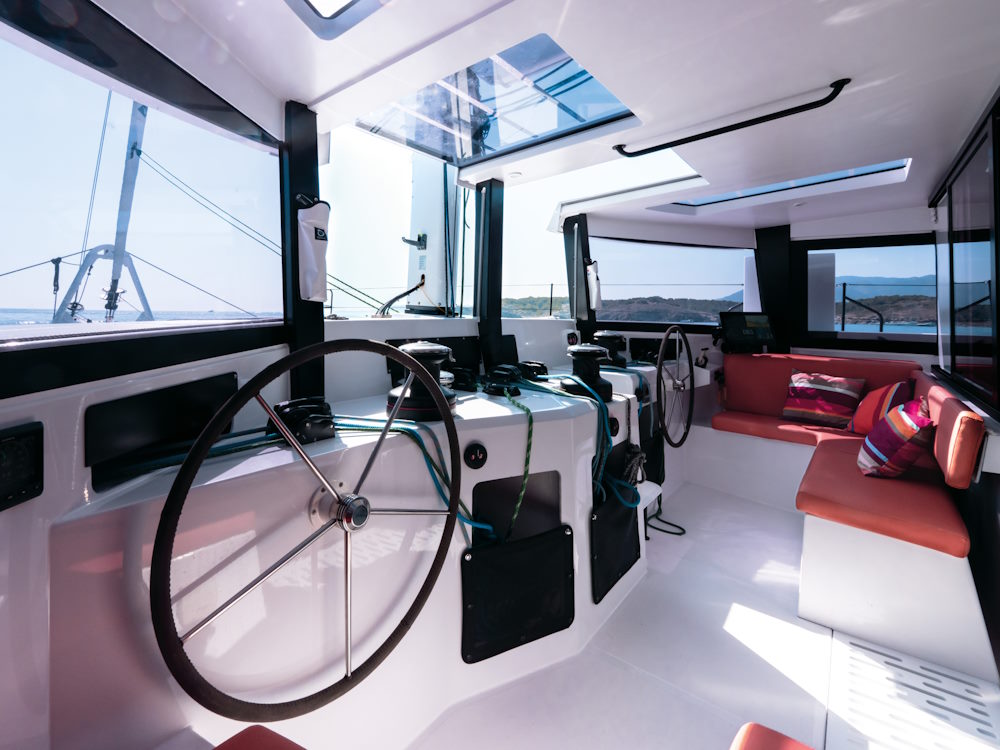
Contact Windelo
More information on the Windelo 50 .
For more information, or to visit the New Windelo 50 Yachting at the 2023 Cannes Yachting Festival, contact Windelo at the email address below

- Lagoon Reaches the 500 Milestone on the 46
Lagoon recently passed the 500 mark for their 46 footer. This popular cruising catamaran continues to attract strong demand thanks to those ocean views from the flybridge, the open sundeck and high levels of comfort in the Interior. They have also launched an option for a furling boom.
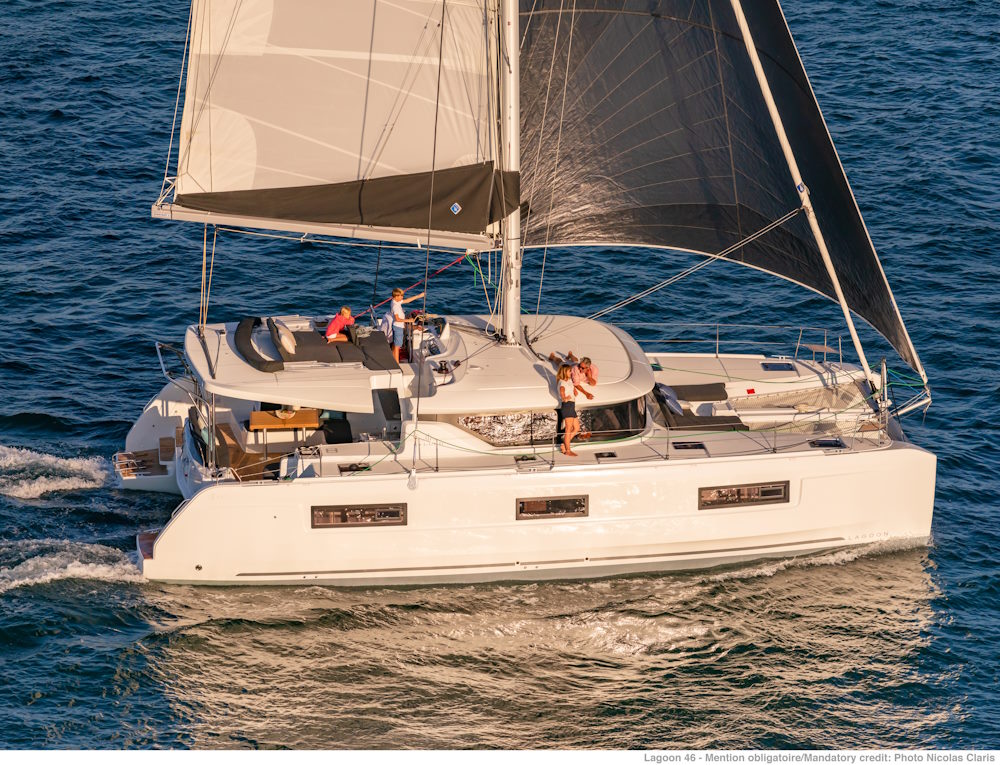
Let’s take a look at the boat in more detail:
Naval architects VPLP have achieved a great balance between the different living spaces aboard the Lagoon 46.
With her front and aft cockpits, cooking area at the back, and a salon that is a home away from home, there are plenty of zones to hang out in.
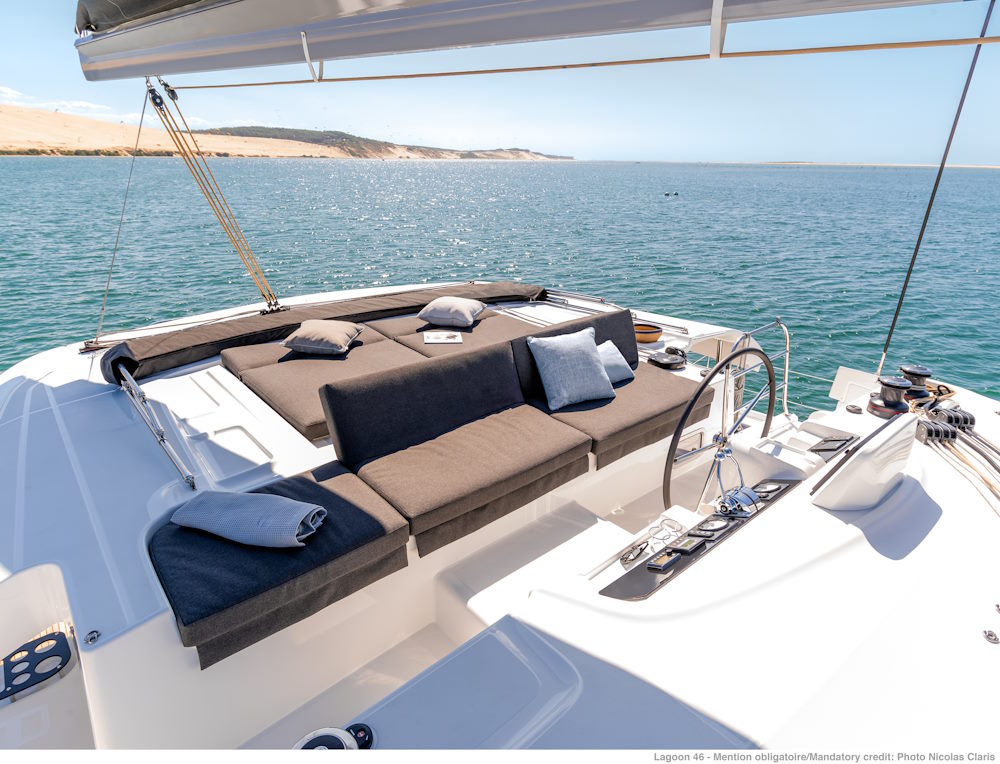
Up top, the Flybridge has a double access port and starboard, and is another zone for relaxation as well as being the control centre when sailing.
Choose between a folding cabriolet or an automated Bimini for sun protection
Head forward, and you have the forward lounge tucked in behind the nets for sundowners.
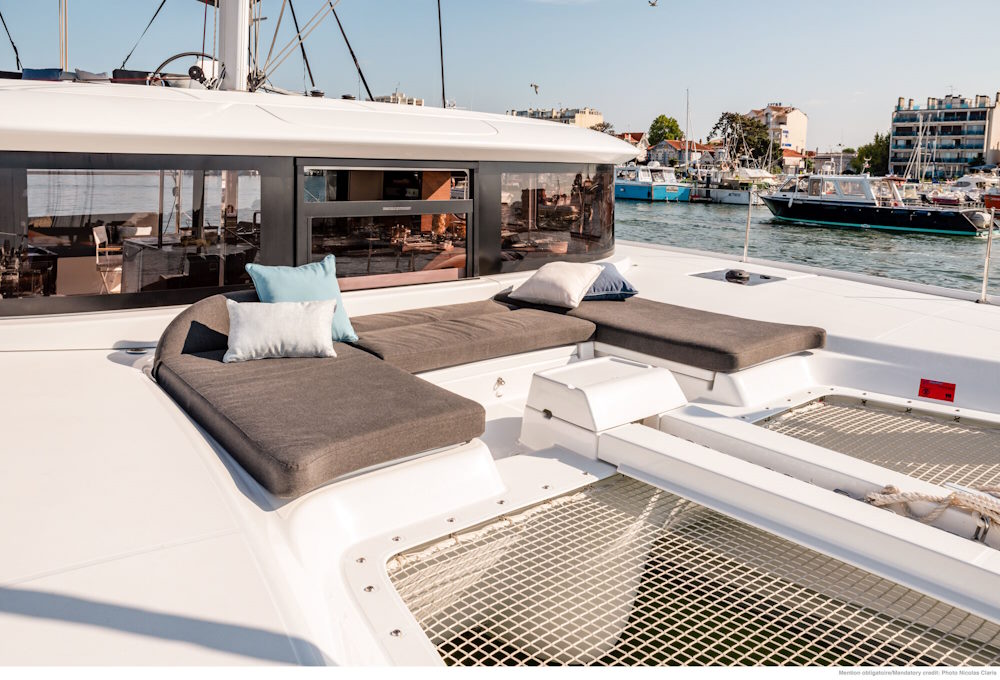
Aft on the Lagoon 46, you can choose between classic stainless steel davits or an electrical hydraulic platform for your tender. The platform allows for easy access to the water at anchor.
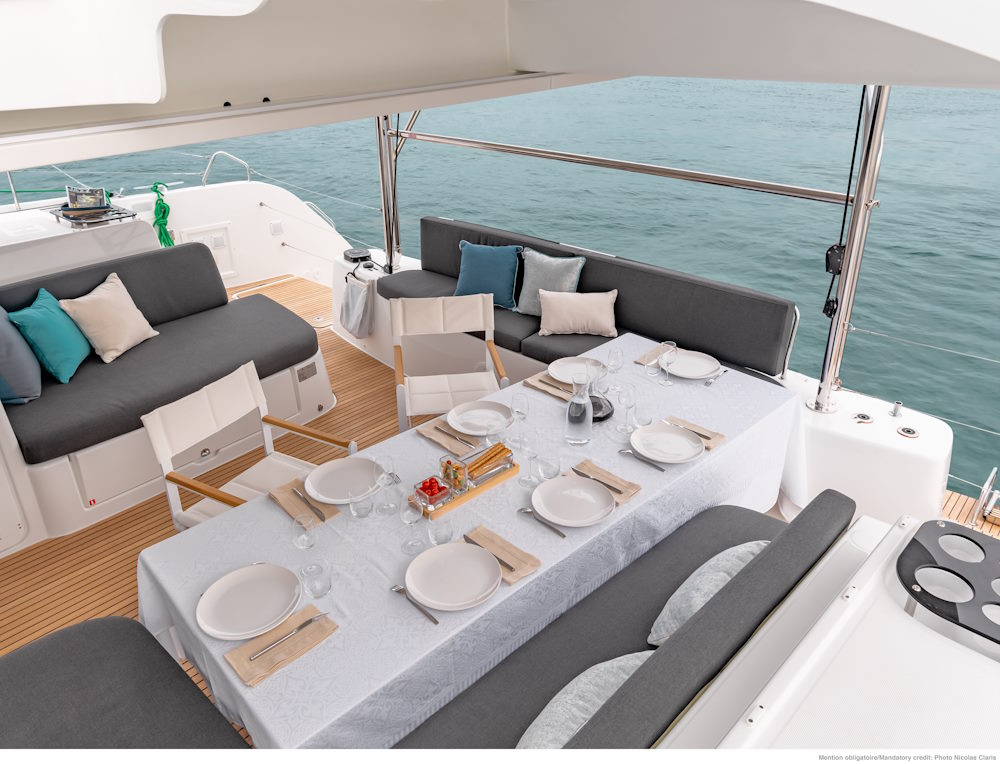
Interior Comfort – a Home Away from Home
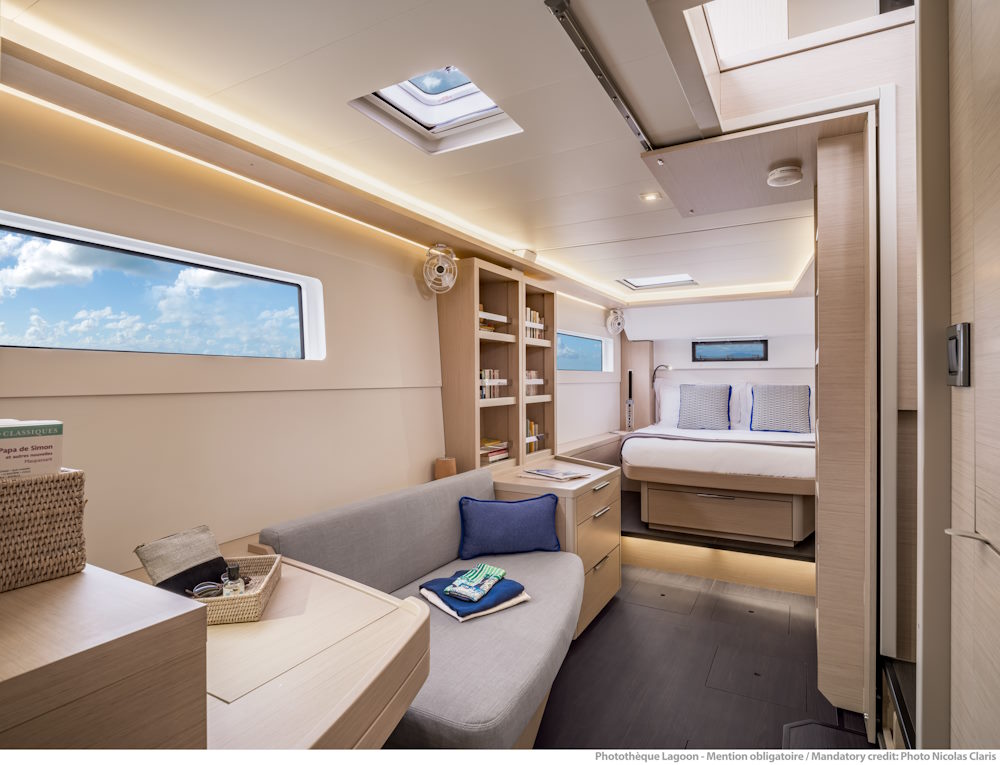
Nauta Design were in charge of developing the elegant interior. The owner’s suite is generously furnished and has an island berth. It’s spacious down here, with a sofa, desk and ample storage. The bathroom is huge with a separate shower.
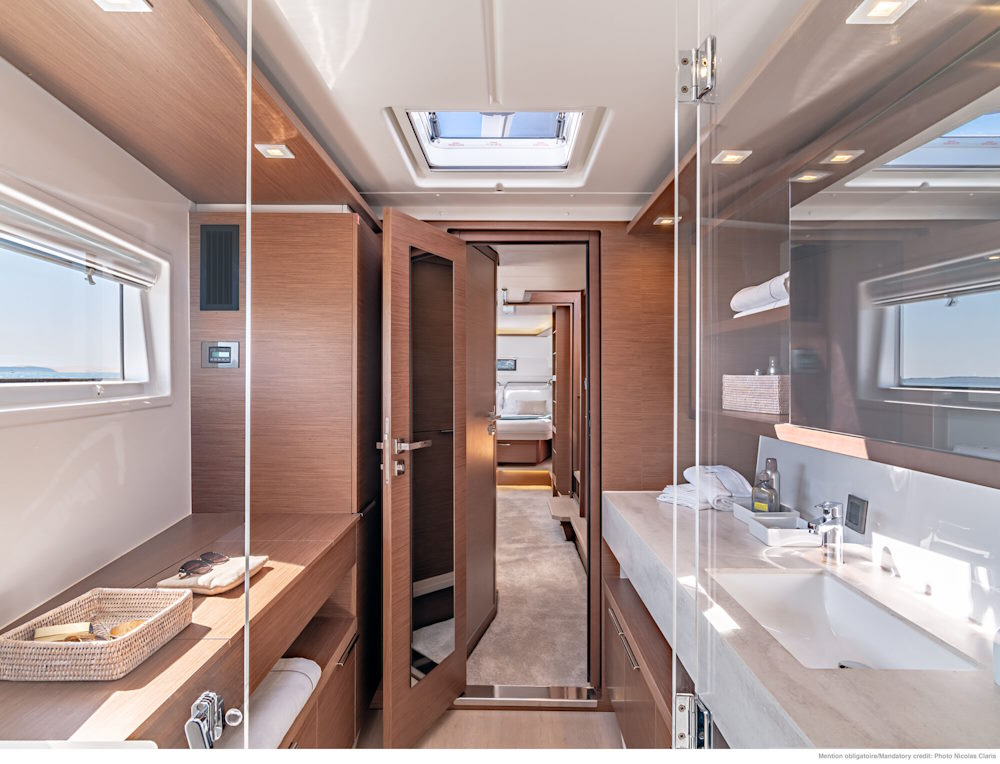
The other cabins aboard are also roomy, especially the forward cabin which also has a large bed.
Up top, the saloon area runs through to the aft cockpit and is light and airy.
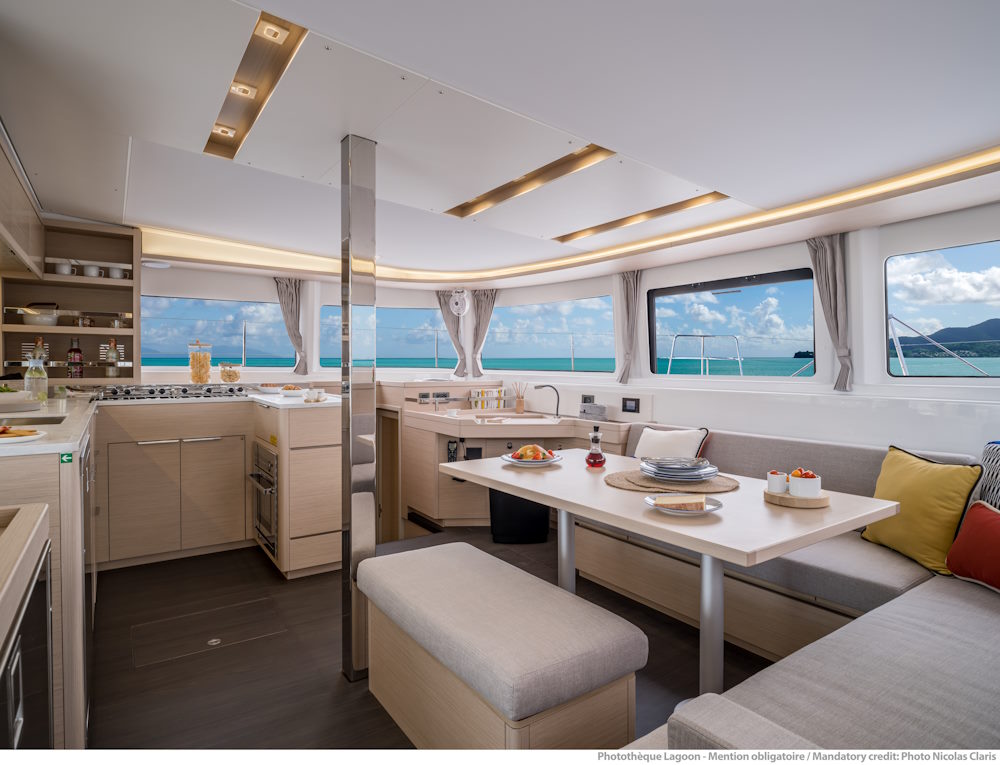
VPLP are known for designing boats that sail, and they have done a great job evolving the Lagoon 46 from her predecessors.
She’s a seaworthy, forgiving boat.
Boom Furler Option
Lagoon recently announced that they are offering a boom furler option on the 46.
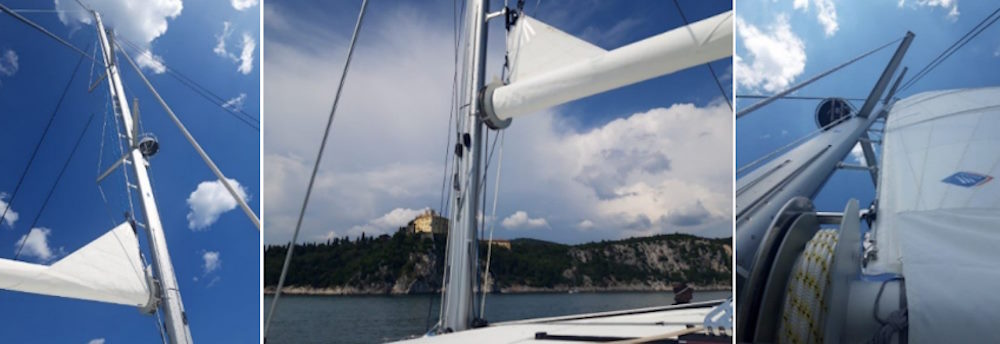
This is a simple, robust solution designed to make the Lagoon 46 even easier to sail. One of the main advantages of the Lagoon boom furler is that the furling mandrel is not enclosed in a housing. So you can watch and control hoisting, reefing and furling manoeuvres.
The Lagoon 46 is a bestseller in the cruising catamaran segment and it is easy to see why. This is a very comfortable, seaworthy boat that has been optimised for easy sailing with many different relaxation zones to enjoy at anchor, including that iconic flybridge.
Next production target, 1000 hulls?
Specifications
- Architects: VPLP design
- Exterior design: Patrick le Quément
- Interior design: Nauta Design
- Length overall: 13.99 m / 45’11”
- Beam: 7.96 m / 26’10”
- Draft: 1.35 m / 4’5”
- Mast clearance: 23,21 m / 76’2”
- Light displacement (EEC): 15,77 t / 34,773 Lbs
- Sail area: 123 m² / 1,323 sq. ft.
- Self tacking jib: 46,5 m² / 500 sq. ft.
- Square top mainsail (opt.): 80,5 m² / 866 sq. ft.
- Engine – 2 x 57 HP
- Fuel capacity: 2 x 520 l / 2 x 137 US gal
- Fresh water capacity: 2 x 300 l / 2 x 79 US gal
- Berths: 6 to 12
- CE certification: A12 / B14 / C20 / D30
- Windsurf Sail Size Chart
We have recently got back into windsurfing. The gear has changed! What’s the right windsurf sail size for the wind strength these days?
The Windsurf Sail Size Chart
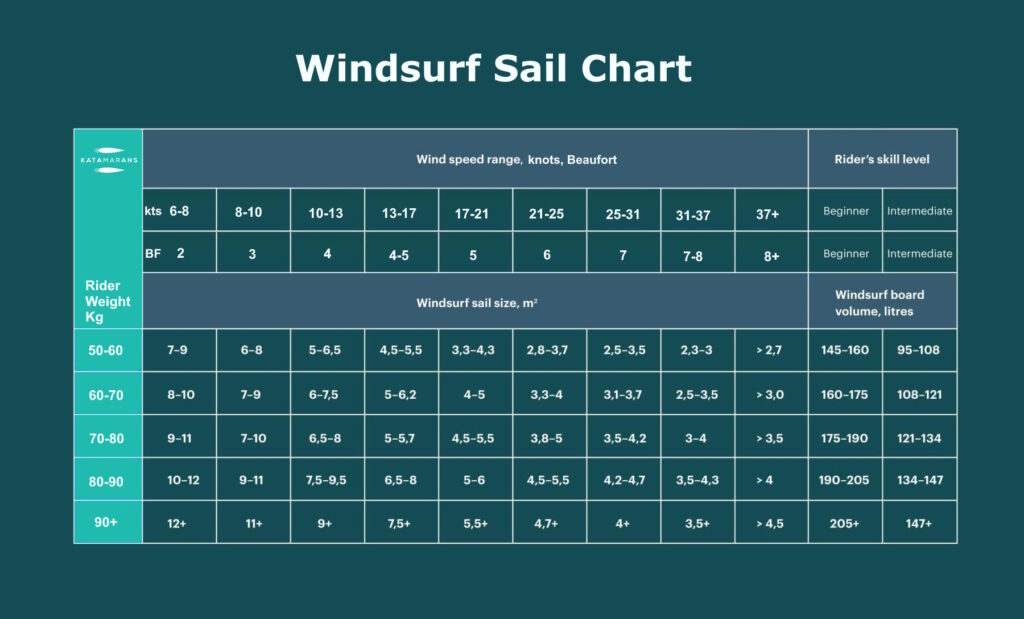
The main variable when choosing a sail for windsurfing is its size. There are all sorts of types of sail of course, but this post just deals with the size aspect.
Head out with the wrong sized sail, and you lose control, or you won’t go anywhere.
Choosing the right sail for windsurfing comes down to:
Skill level The better you are, the larger sail you will manage.
Average wind speed The stronger the wind, the smaller sail you are going to need.
Your Weight The heavier you are, the larger the sail you will manage before becoming overpowered.

- Excess Sensations or Excess Cruising?
Excess Catamarans have worked hard to develop cruising yachts that are fun to sail and comfortable to live aboard.
The Excess 12 and 15 were launched in 2019.
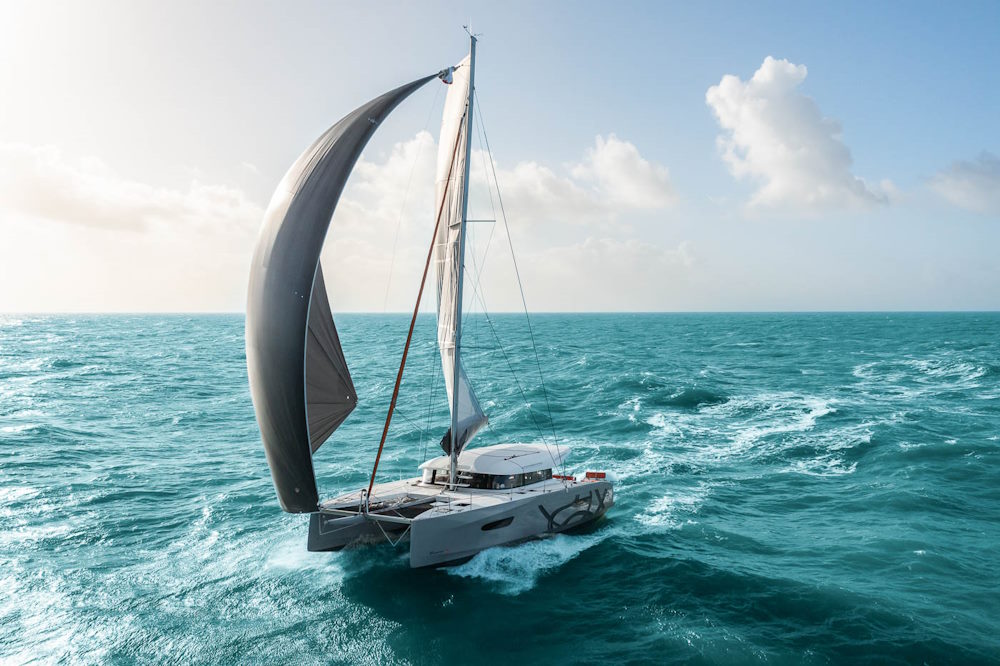
Then, in 2020 the French manufacturer launched the Excess 11 and the first Excess 14 splashed in 2022.
This 46 footer was designed by VPLP with feedback from customers and Excess owners via the Excess Lab, a forum to gather feedback and design ideas.
The Excess 14 strikes a good balance between performance and comfort in a cruising package. It’s a catamaran that has carved out its own space in the cruising market.
Let’s take a look at some of the features that they have developed.
Excess Sensations
One thing I have noticed about this catamaran manufacturer is that the team, led by Thibaut de Montvalon, is very focused on what they want to be and how they want to get there.
Having a clear vision and communicating it well is half the battle for organisations, and you’ll hear Excess often talk about “Sensations” – it’s a key driver for them. They want their owners, dealers and employees to enjoy sailing Excess yachts. It’s one of the reasons why this brand is attracting many monohull sailors.
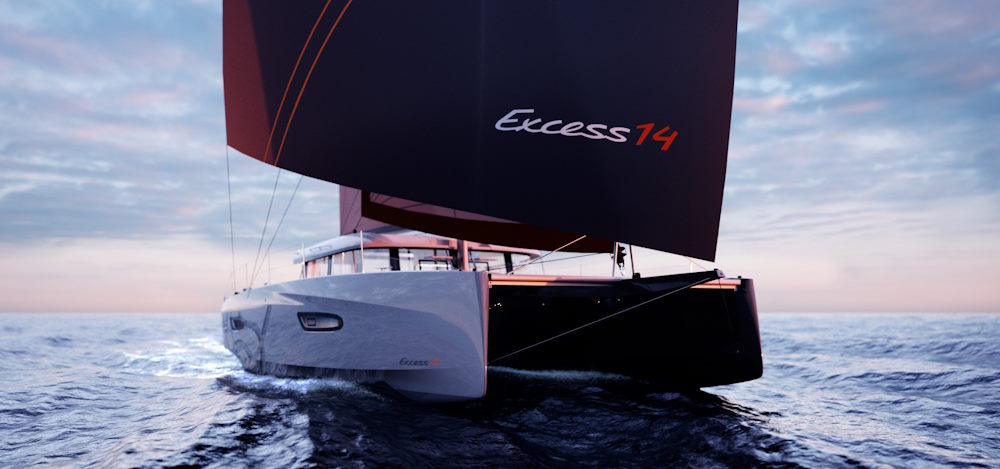
Sailing feel is a key design element in the 14. She has a sporty, low slung boom, asymmetric hulls, refined keels and is built with lightweight materials.
If you opt for the Pulse Line package, you can boost the upwind sail area by 10% to 135 m² (1,453 sq.ft) from 123 m² (1,323 sq.ft).
Built to Sail The low boom, lower freeboard with reduced windage and sleek lines gives the 14 distinctive look. She has aft-set coach-roof, a forward-stepped mast, a composite bowsprit as standard and inverted bows.
The fins have been optimised for beating to windward, and the rudder blades have been extended.
VPLP and Excess have designed the 14 with a forward-set rig, a square-top mainsail, and a large overlapping genoa as standard to optimize the sail area to displacement ratio.
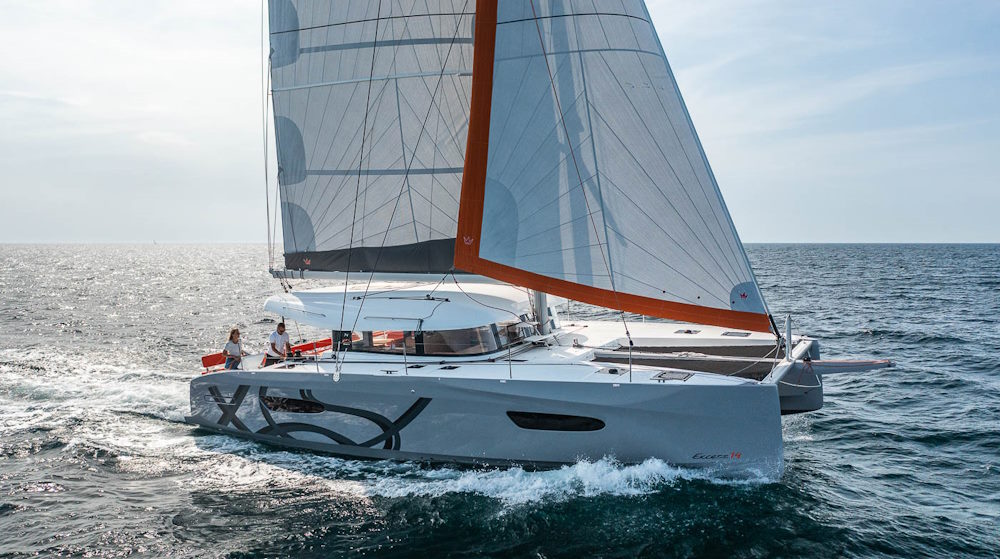
Bridgedeck clearance has been increased for better passage through the water, and the hulls designed asymmetrically to reduce drag. The low boom moves the centre of effort of the mainsail down and she has been built with foam sandwich and carbon reinforcements.
With a full complement of lighter wind sails flying off the bowsprit, this is a catamaran that should keep the smile on your face when the wind is blowing.
Sail Close to the Water The helm stations are set aft with optional biminis, so you have a direct connection with the rudders and a good view of the sails.
Visibility has been optimised though untinted saloon windows.
The direct steering system uses textile lines, for a better helm feel.
The aft helms have an important safety aspect as well – all of the crew are forward of the skipper in his or her line of sight.
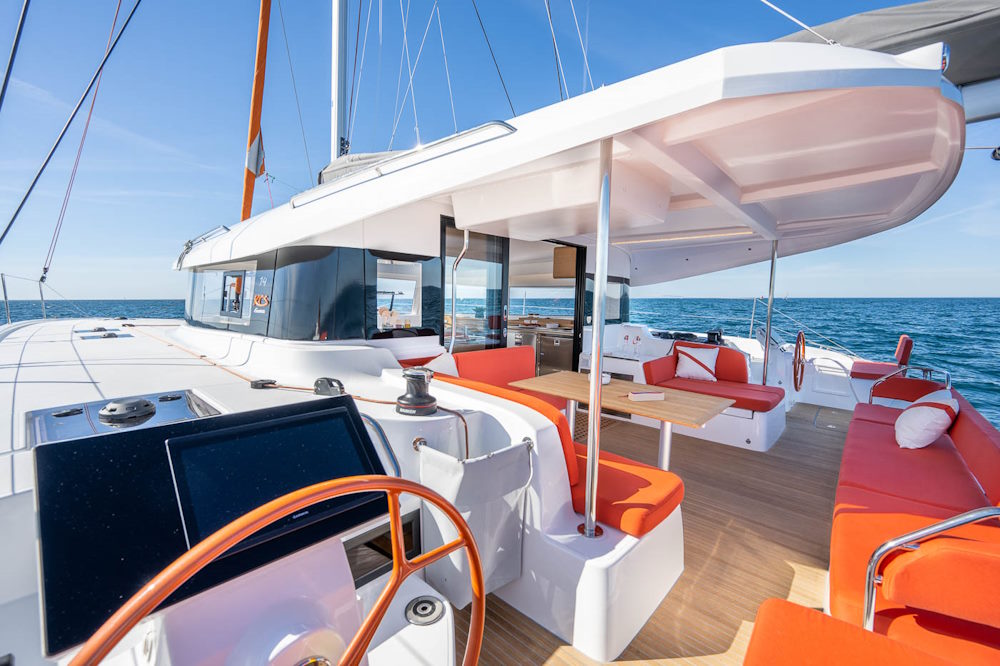
Performance Summary
VPLP, Excess and their customers have worked hard here to develop a good balance of performance and comfort with:
- A low boom and low centre of effort from the wind.
- A sporty sail area to displacement ratio particularly on the Pulse Line (26.5) which approaches some performance cat ratios. The overlapping genoa and composite bowsprit all help.
- Asymmetric hulls and optimised keels and rudders for upwind performance.
- Aft helms mean you sail close to the water with full view of the sails connected directly to the rudders.
- Construction from foam sandwich with carbon reinforcements results in a stiff, strong boat.
Excess Cruising
This is only half the story though, as the Excess 14 has been designed to deliver a decent performance level without compromising on comfort.
Comfort and Flexibility This cruising catamaran offers high levels of comfort and flexibility in its living spaces. Volume and good headroom are priorities in a warm and bright environment.
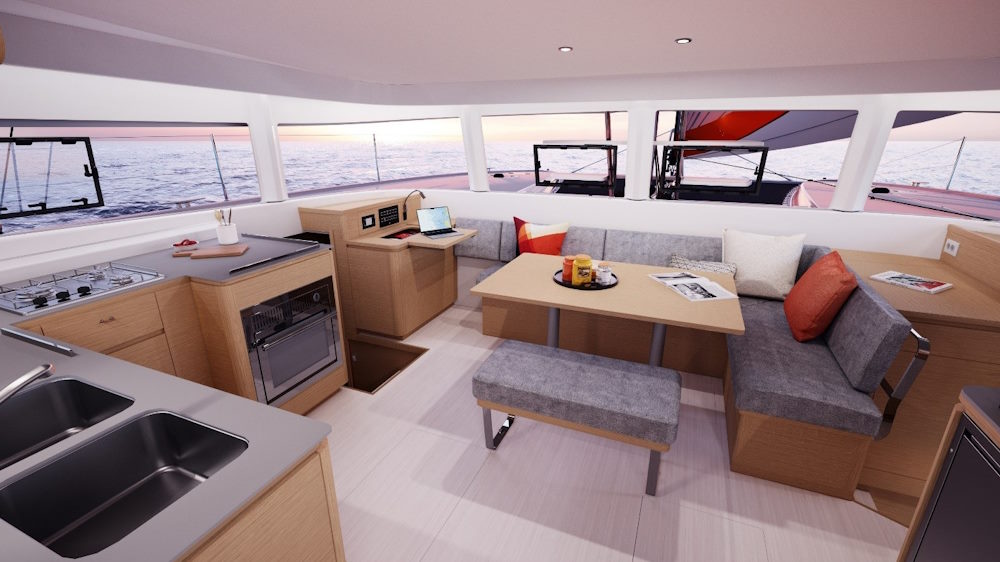
Down below, in the hulls, you’ll find wide, comfortable beds, and bathrooms with a separate shower. Large and subdivided storage spaces have been designed to store your gear efficiently, with some great touches like the retractable chart table.
Optimise your layout Everyone’s needs are different of course, so they have designed this catamaran with plenty of layout options.
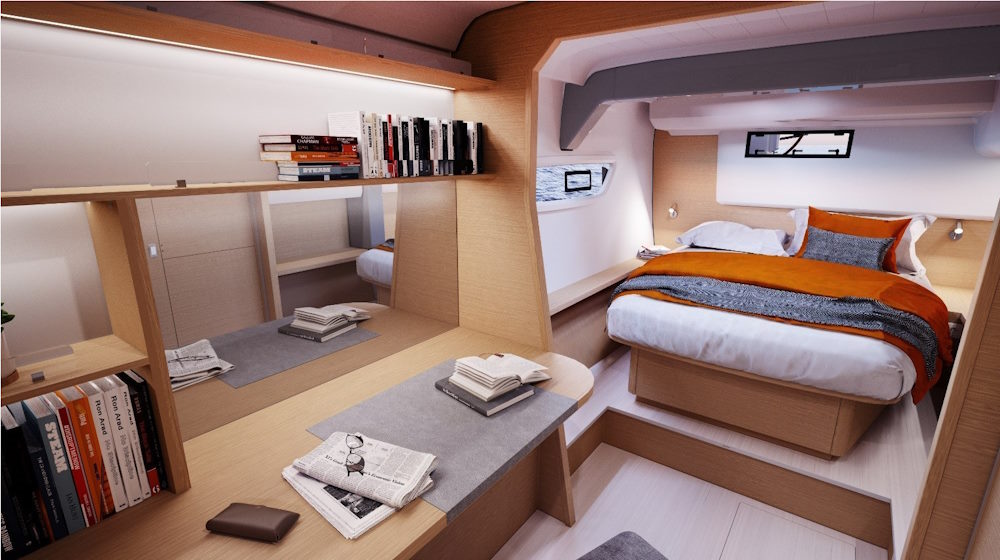
3 Cabins In the 3-cabin version, the main features are :
-A central bathroom -A large private dressing area -Extra bunks as an option 4 Cabins -Up to four cabins, four heads & four separate showers – An optional skipper cabin in each hull
The Skylounge An innovative solution on the coachroof – a spot for sundowners at anchor that does not compromise the low boom height.
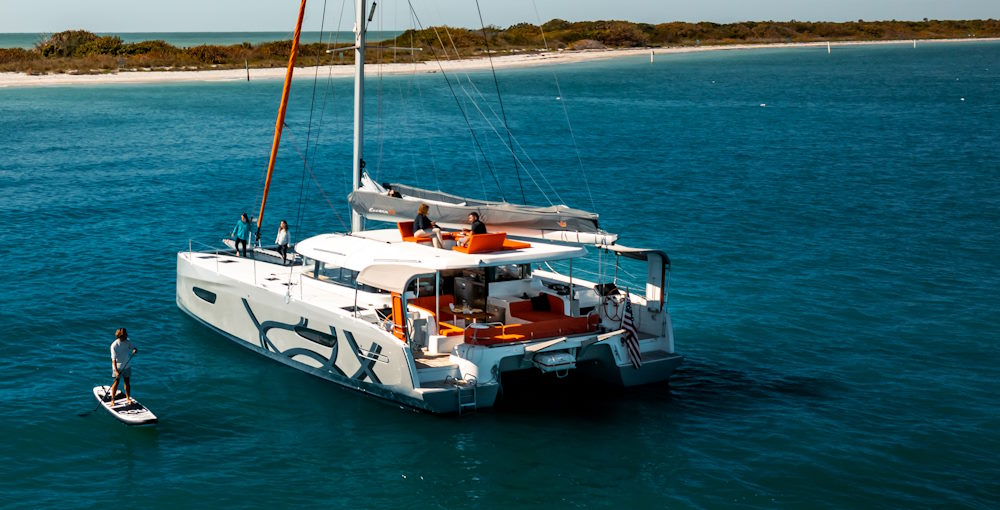
Dressing Room An option for a walk-in dressing room allows you to store both sailing gear and clothes. You can configure this with additional twin berths, for a family configuration.
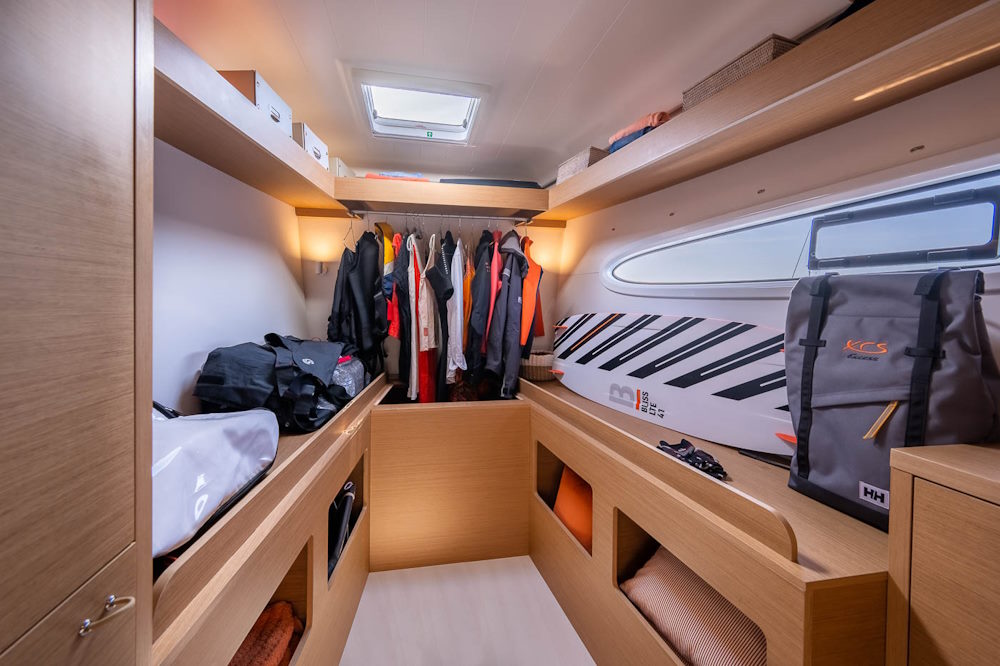
Comfort Summary
There is no denying that this a a very comfortable boat, particularly if you opt for the owner’s configuration (3 cabin). The aft helms allow for a large, connected living space up top, and down below the cabins and bathrooms are roomy and there is plenty of storage.
With the flexibility offered with the dressing room and the sky lounge on the coach-roof, it’s an appealing package.
Sails Square top mainsail 83 m² | 893 sq ft
Overlapping genoa 40 m² | 430 sq ft
Code 0 (option) 72 m² | 775 sq ft
Upwind sail area 123 m² | 1323 sq ft
PULSE LINE Upwind sail area 135 m² | 1453 sq ft Code 0 [option] 86 m² | 926 sq ft
Dimensions Length overall (depends on options) 13.97 to 15.99 m | 45’9’’ to 52’5’’
Hull length 13.34 m | 43’9’’
Light displacement [EC] 12,8 T | 28219 lbs
Beam 7.87 m | 25’9’’
Mast clearance (std/pulse) 19.78 m | 64’11’’ / 21.54 m | 70’8’’
Draft 1.48 m | 4’10’’
CE certification A : 10 – B : 12 – C : 16 – D : 20
Other Fuel capacity 2 x 200 L 2 x 53 US gal
Engines 2 x 45 HP 2 x 57 HP (option)
Fresh water capacity 300 L (standard) + 300 L (option) 79 + 79 US gal (option)
Holding tank capacity 2 x 80 L 2 x 21 US gal
Berths 6 to 12
Browse, search and find your perfect catamaran!
Privacy Overview
- Custom Cats
- Performance Cats
- Cruising Cats
- Luxury Cats
- Owner Reviews
- YT Channels
- OC Wally Cento
- 84 Mini Maxi
- IMOCA Open 60
- Consultancy Services
- 30m Blue Water Cruiser
- 25m Explorer Yacht
- 24m Fast Cruising Catamaran
- 23m Performance Cruiser
- 20m Explorer Yacht
- 20m High Performance Cruiser
- 18m Blue Water Cruiser
- 15m Performance Cruiser
- 15m Explorer Yacht
- 12m Explorer Yacht
- Multihull Design
- 18m Explorer Yacht
- 40m Blue Water Cruiser
- 40m Cruiser Racer
- 33m Performance Cruiser
- 30m Wally Cento
- 24m ORCsy Racer Cruiser
- 24m Day Sailer
- Carbon Component Design
- Yacht Performance Development
- CFD and Model Testing
- Twin Rudder Steering Systems
- Custom Deck Hardware
- Modifications and Refit
- VPP Routing and Sail Analysis
- Classic Yacht Refit & Optimisation
- Naval Architecture
- Engineering
- Rudder Design
- Brokerage Services
- 'Seahorse Magazine' #192
- Lucent #180
- Influence #171
- 'Eora' #169
- 'The Three Brothers' #168
- 'Edenred' #165
- Polka Dot #154
- 'Teata' #148
- ‘Sensei’ #131
- 'Sabre II' #93
- French Pineapple #79
- 'Letto Di Pletto' #47
- 'Mowgli' #41
- 23.8m Ultime Trimaran
- 20.7m Orma Trimaran
- 18.28m Orma Trimaran
- 16.75m Cruising Catamaran
- 16.1m Cruising Catamaran
- 12.8m Crowther Shockwave Catamaran
- 9.1m Seacart 30 Trimaran
- 26.3m Aluminium Sloop
- 22.38m Aluminium Classic Yacht
- 21.0m Steel Schooner
- 21.0m Aluminium Cruising Ketch
- 20.0m Aluminium Explorer Yacht
- 20.0m Luca Brenta Racer Cruiser
- 19.6m Aluminium Bluewater Cruiser
- 19.2m Aluminium Lifting Keel Sloop
- 18.23m Mylius Racer Cruiser
- 16.0m Sly Cruiser Racer
- 14.5m Aluminium Cruising yacht
- 13.87m Wooden Motor Sailer
- 11.6m Classic Pilot Cutter
- 25.25m Reichel Pugh Maxi
- 18.28m IMOCA 60 One Planet
- 18.28m O Canada IMOCA Open 60
- 18.28m Come in Vendee Open 60
- 18.23m Mylius FD Racer Cruiser
- 15.84m TP52 Racing Yacht
- 15.25m Pegasus Open 50
- 10.89m Figaro 3
- 10.1m Figaro 2
- 14.5m Aluminium Cruising Yacht

Catamaran Racing News – Flo1 by Aeronamics (article)
Aeronamics has created the Flo1 which makes the flying experience accessible to a large group of sailing enthusiasts. It is both spectacular and easy to sail.
Simplicity, durability and speed, the Flo1 was designed around these criteria. Aeronamics has designed a stable hull that works very well in foiling mode as well as in skimming mode. No hassle to launch the boat, no fragile structures and a very high-speed potential. Because of the split mast, you have the option to transport the Flo1 not only on a trailer but also on the car roof.
In experienced hands, the little racer can reach speeds of over 20 knots. However, the principal aim of the new boat was not speed, but to make foiling simple. It is made possible by the self-stabilizing character of the hull. In light winds, the boat reaches boat speeds of 6 to 8 knots and already starts to lift out of the water. Thanks to the integrated DSS system, it is easy to handle for any sailor.
The result is a practical boat with a modern design using sustainable materials.
Length 4.25m Width: 1.8m Foiling width: 2.3m Draft: 0.95m (daggerboard down) – safety release on pivoting daggerboard
Hull weight: 55 kg Minimum true wind foiling: 6-9 kn
Carbon split mast Stayed rig
Carbon boom Glass-Epoxy hull Carbon DSS foils Carbon daggerboard Carbon T-rudder
Quantum batten Main poly black (10.5m 2 )
Ronstan/Spinlock deck layout Dutch design & built, Pwrdby Q
Measured top speed: 22 kn
Price: €14.159,50 Ex VAT, Ex Works.
Unique 3 sailing modes:
- foils up ‘displacement mode’ and sails like a standard dinghy
- both foils down, full foiling, and really stable
- windward foil up, the boat comes more playful and challenging
At the moment we are creating a class with the help and support of partners to create an international race fleet tough a leadership board app. This way we create an International Racing Fleet, but when and where you want!
Stay up-to-date by subscribing to their newsletter and follow Aeronamics on Facebook or Instagram !
—————————————————————————–
Source: Catamaran Racing News

Catamarans Market Report 2024: Strategies And Recent Developments | African Cats B V, Voyage Yachts Ltd., Bavaria Yachtbau GmbH, Catana Group SA, Seawind Group Holdings Pty Ltd., Outremer Catamarans, Fountaine Pajot SA, LeisureCat & AussieCat, Robertson &
Press release from: the buisness research company.

Catamarans Market Size
Permanent link to this press release:
You can edit or delete your press release Catamarans Market Report 2024: Strategies And Recent Developments | African Cats B V, Voyage Yachts Ltd., Bavaria Yachtbau GmbH, Catana Group SA, Seawind Group Holdings Pty Ltd., Outremer Catamarans, Fountaine Pajot SA, LeisureCat & AussieCat, Robertson & here
Delete press release Edit press release
More Releases from The Buisness Research Company

All 5 Releases
More Releases for Cat
- Categories Advertising, Media Consulting, Marketing Research Arts & Culture Associations & Organizations Business, Economy, Finances, Banking & Insurance Energy & Environment Fashion, Lifestyle, Trends Health & Medicine Industry, Real Estate & Construction IT, New Media & Software Leisure, Entertainment, Miscellaneous Logistics & Transport Media & Telecommunications Politics, Law & Society Science & Education Sports Tourism, Cars, Traffic RSS-Newsfeeds
- Order Credits
- About Us About / FAQ Newsletter Terms & Conditions Privacy Policy Imprint

The Ultimate Guide to Choosing Between a Sailboat or Catamaran for Your Sailing Adventures
C hoosing between a sailboat and a catamaran for your sailing adventures is a significant decision that depends on various factors, including your sailing preferences, experience level, budget, and intended use. Here's an ultimate guide to help you make an informed decision:
1. Sailing Experience:
- Sailboats: Typically require more skill and experience to handle, especially in adverse weather conditions. Ideal for sailors who enjoy the traditional feel of sailing and are willing to invest time in learning and mastering the art.
- Catamarans: Easier to handle, making them suitable for beginners. The dual-hull design provides stability, reducing the learning curve for those new to sailing.
2. Space and Comfort:
- Sailboats: Generally have a narrower beam and less living space. However, some sailboats may offer comfortable cabins and amenities.
- Catamarans: Wider beam creates more living space. Catamarans often have multiple cabins, spacious saloons, and expansive deck areas, providing a more comfortable living experience.
3. Stability:
- Sailboats: Monohulls can heel (lean) while sailing, which some sailors enjoy for the thrill but can be discomforting for others.
- Catamarans: Greater stability due to the dual hulls, providing a more level sailing experience. Reduced heeling makes catamarans suitable for those prone to seasickness.
4. Performance:
- Sailboats: Known for their upwind performance and ability to sail close to the wind. Some sailors appreciate the challenge of optimizing sail trim for efficiency.
- Catamarans: Faster on a reach and downwind due to their wide beam. However, they may not point as high into the wind as monohulls.
- Sailboats: Typically have a deeper draft, limiting access to shallow anchorages and requiring deeper marina berths.
- Catamarans: Shallow draft allows access to shallower waters and secluded anchorages, providing more flexibility in cruising destinations.
- Sailboats: Generally more affordable upfront, with a wide range of options available to fit different budgets.
- Catamarans: Often more expensive upfront due to their size and design. However, maintenance costs may be comparable or even lower in some cases.
7. Mooring and Docking:
- Sailboats: Easier to find slips and moorings in marinas designed for monohulls.
- Catamarans: Require wider slips and may have limited availability in certain marinas, especially in crowded anchorages.
8. Intended Use:
- Sailboats: Ideal for traditional sailors who enjoy the art of sailing, racing enthusiasts, or those on a tighter budget.
- Catamarans: Suited for those prioritizing comfort, stability, and spacious living areas, especially for long-term cruising and chartering.
9. Resale Value:
- Sailboats: Generally have a more established resale market, with a wider range of buyers.
- Catamarans: Growing in popularity, and well-maintained catamarans often retain their value.
10. Personal Preference:
- Consider your personal preferences, the type of sailing you plan to do, and the kind of lifestyle you want aboard your vessel.
In conclusion, both sailboats and catamarans have their advantages and disadvantages. Your decision should be based on your individual preferences, experience level, budget, and intended use. If possible, charter both types of vessels to experience firsthand how they handle and to help make a more informed decision based on your own preferences and needs.
The post The Ultimate Guide to Choosing Between a Sailboat or Catamaran for Your Sailing Adventures appeared first on Things That Make People Go Aww .


IMAGES
VIDEO
COMMENTS
F18 Martinique Cataraid 2024: Win for Noordzij & Tentij. - All images Pierrick Contin / Martinique Cataraid. Official Regatta web:... January 27, 2024. F18 Australian Nats 2024. Day 3 Results. - All images courtesy of Russell Witt. More at his fb... January 26, 2024.
F18 Arg Mar del Plata Sailing Week 2024. D2 pics & results at Catsailingnews web. Photo: Machi Contessi
- All images Jorge Cousillas / Elojonautico F18 Argentinean Nats 2023... Uncategorized. December 11, 2023
Mazuay & Guignard #1st. Only one more race could be completed at Barcelona Sailing center... November 4, 2023. Nacra 15 Super Series 2023. Barcelona Day 1. - Nacra 15 European Super Series 2023 Nov 2-5 are being... November 1, 2023.
Catamaran Racing, News & Design. 11,578 likes · 67 talking about this. https://Catsailingnews.com
Multihull Sailing News. Catamarans and trimarans have gone from occupying the fringe of the sailing world to the front and center. Whether it's a cruising catamaran, a bluewater racing trimaran or the latest red-hot racing beach cat, you can always count on these boats and the people who sail them for some excitement afloat. Racing.
Catamaran Racing Retweeted. GUNBOAT. @Gunboat_News. ·. Nov 23, 2022. Applying race boat technology on a fully equipped cruising yacht is complex, nuanced, and a matter of perspective - sophisticated modeling tools help designer, builder and client establish the same vision... bit.ly/3OArWZo #gunboat #yachting. @VPLPYachtDesign.
Owners' cabins are luxurious, airy, and spacious serving as a very comfortable living space, rather than just a place to sleep. 3. Wave-Piercing or Reverse Bows. Wave-piercing or reverse bows are considered cutting-edge naval architecture and one of the latest popular catamaran. design trends.
BlackCat 36m. LOA 36m. Beam 13.7m. Draught 1.60-4.90m. Passengers 8 guests, 4 crew. Designer Malcolm McKeon and BlackCat founder Mitch Booth have been busy creating a super-sleek new 36-metre catamaran concept for a specific owner, and are now offering it alongside its other models in the 30- to 50-metre range.
The first CM46 is a full carbon racing version destined for an Auckland-based owner and is due to launch early 2021. The second boat (for Wadhams) has a more cruising-oriented spec. Prices ex VAT ...
Catamaran Racing, News & Design - Facebook
Founded in 2011 by Yann Guichard and Dona Bertarelli—sister of Ernesto of America's Cup fame—the express purpose of Sprindrift Racing is to push the envelope in terms of multihull sailing. To this end, the team invested in three separate boats: a Decision 35 one-design catamaran for inshore racing, an MOD 70 trimaran and—most ...
The most important catamaran design hull shape factor, is the Prismatic Coefficient (Cp). This is a measure of the fullness of the ends of the hull. Instinctively you might think that fine ends would be faster as they would "cut through the water better". But in fact you want a high Cp for high speeds.
Multihull Design Trends. For sailors of a certain age, the entire concept of a mulithull is cutting edge. However, even a cursory glance at a harbor full of cats and tris will show that the "cutting edge" of today looks very different from the cutting edge of, say, the '90s, or even the early 2000s—to the point where today's cats and ...
It means you "lose" around 60 % of fuel within the process. Lots of internal mobile parts generate friction and heat which is the main loss. Furthermore, most catamarans use saildrives. This transmission choice, saves space inside the hulls, but comes with around 10% more losses (gears) compared to a shaft drive.
Owen Clarke Design began as sailing multihull designers, sailors and project managers. Our first multihull was Fiery Cross a racing trimaran design by Merfyn Owen in 1987. Their first custom cruising yacht was Syn Y Mor, a 30' fast cruising catamaran and the first collaboration with Allen Clarke. In recent years they worked with clients on a Multi50 trimaran project and most recently 20m racer ...
A Formula 16 beachable catamaran Powered catamaran passenger ferry at Salem, Massachusetts, United States. A catamaran (/ ˌ k æ t ə m ə ˈ r æ n /) (informally, a "cat") is a watercraft with two parallel hulls of equal size. The distance between a catamaran's hulls imparts resistance to rolling and overturning. Catamarans typically have less hull volume, smaller displacement, and ...
Nacra Sailing is a Dutch company that manufactures a line of small catamaran sailboats, or beachcats. NACRA was founded in 1975 to tap into the market created by Hobie Alter the founder of Hobie Cat, and several other companies offering small fiberglass catamarans designed to be sailed off the beach by a crew of one or two.. NACRA is an acronym that stands for North American Catamaran Racing ...
Have you ever wondered the processes that go into Catamaran design and building a Catamaran? Maybe. Maybe not.However for those of you who are contemplating ...
Dutch design & built, Pwrdby Q. Measured top speed: 22 kn. Price: €14.159,50 Ex VAT, Ex Works. Unique 3 sailing modes: foils up 'displacement mode' and sails like a standard dinghy; both foils down, full foiling, and really stable; windward foil up, the boat comes more playful and challenging
Press release - The Buisness Research Company - Catamarans Market Report 2024: Strategies And Recent Developments | African Cats B V, Voyage Yachts Ltd., Bavaria Yachtbau GmbH, Catana Group SA ...
Choosing between a sailboat and a catamaran for your sailing adventures is a significant decision that depends on various factors, including your sailing preferences, experience level, budget, and ...